Itinerary
Sprawling Reykjavík, the nation’s nerve center and government seat, is home to half the island’s population. On a bay overlooked by proud Mt. Esja (pronounced eh-shyuh), with its ever-changing hues, Reykjavík presents a colorful sight, its concrete houses painted in light colors and topped by vibrant red, blue, and green roofs. In contrast to the almost treeless countryside, Reykjavík has many tall, native birches, rowans, and willows, as well as imported aspen, pines, and spruces.Reykjavík’s name comes from the Icelandic words for smoke, reykur, and bay, vík. In AD 874, Norseman Ingólfur Arnarson saw Iceland rising out of the misty sea and came ashore at a bay eerily shrouded with plumes of steam from nearby hot springs. Today most of the houses in Reykjavík are heated by near-boiling water from the hot springs. Natural heating avoids air pollution; there’s no smoke around. You may notice, however, that the hot water brings a slight sulfur smell to the bathroom.Prices are easily on a par with other major European cities. A practical option is to purchase a Reykjavík City Card at the Tourist Information Center or at the Reykjavík Youth Hostel. This card permits unlimited bus usage and admission to any of the city’s seven pools, the Family Park and Zoo, and city museums. The cards are valid for one (ISK 3,300), two (ISK 4,400), or three days (ISK 4,900), and they pay for themselves after three or four uses a day. Even lacking the City Card, paying admission (ISK 500, or ISK 250 for seniors and people with disabilities) to one of the city art museums (Hafnarhús, Kjarvalsstaðir, or Ásmundarsafn) gets you free same-day admission to the other two.
Day programme:
Arrive at the international airport in Keflavik and transfer independently to your included hotel in Reykjavik. Depending on your arrival time, you may wish to explore Iceland’s fascinating capital. Many cultural and historical landmarks are located in or near the walkable city center.
Sprawling Reykjavík, the nation’s nerve center and government seat, is home to half the island’s population. On a bay overlooked by proud Mt. Esja (pronounced eh-shyuh), with its ever-changing hues, Reykjavík presents a colorful sight, its concrete houses painted in light colors and topped by vibrant red, blue, and green roofs. In contrast to the almost treeless countryside, Reykjavík has many tall, native birches, rowans, and willows, as well as imported aspen, pines, and spruces.Reykjavík’s name comes from the Icelandic words for smoke, reykur, and bay, vík. In AD 874, Norseman Ingólfur Arnarson saw Iceland rising out of the misty sea and came ashore at a bay eerily shrouded with plumes of steam from nearby hot springs. Today most of the houses in Reykjavík are heated by near-boiling water from the hot springs. Natural heating avoids air pollution; there’s no smoke around. You may notice, however, that the hot water brings a slight sulfur smell to the bathroom.Prices are easily on a par with other major European cities. A practical option is to purchase a Reykjavík City Card at the Tourist Information Center or at the Reykjavík Youth Hostel. This card permits unlimited bus usage and admission to any of the city’s seven pools, the Family Park and Zoo, and city museums. The cards are valid for one (ISK 3,300), two (ISK 4,400), or three days (ISK 4,900), and they pay for themselves after three or four uses a day. Even lacking the City Card, paying admission (ISK 500, or ISK 250 for seniors and people with disabilities) to one of the city art museums (Hafnarhús, Kjarvalsstaðir, or Ásmundarsafn) gets you free same-day admission to the other two.
Day programme:
Enjoy your complimentary breakfast at the hotel. Your transfer to the ship is scheduled for the afternoon, leaving you time to explore Reykjavik in the morning and have lunch on your own before you rendez-vous back at the hotel for the bus transfer to the port. Embarkation is scheduled for 4 pm. You’ll be notified of official welcome and safety briefings as we set sail for the Westfjords.
Day programme:
Each region of Iceland has its own appeal for nature seekers, birding enthusiasts and history-lovers, and the seldom-visited Westfjords, where the land meets the sea in the most dramatic fashion, is no exception. Often referred to as “Iceland’s best-kept secret,” this rugged peninsula at the country’s remote northwestern tip is rife with fjords, and mountains that slope gracefully down to the sea. We spend our time exploring the fjords and shores of Iceland’s oldest region, enjoying its kaleidoscope of diverse land and seascapes. Here, tumbling cliffs and gushing waterfalls alternate with colorful beaches, and rolling green hills lead up to high moorlands dotted with rocky outcrops, small lakes, and the occasional shaggy Icelandic sheep or pony grazing in the distance. A few modest outposts of civilization, in the form small fishing communities nestled along the fjords and shores of the Denmark Strait, face out into the mighty Atlantic—keeping alive a maritime heritage that dates back to the Viking days. One of today’s highlights is a chance to visit Vigur, a private island that provides guests with unique opportunities to delve into Icelandic culture and heritage as early as the 11th century. Vigur is widely regarded as a capsule of Icelandic heritage.” Upon arriving on shore by Zodiac, we will be welcomed by the people who own this incredible island. One of the co-owners is polar explorer Felicity Aston, the first woman to ski solo across Antarctica. You’ll learn about the Icelandic tradition of eiderdown harvesting, and the wide array of Arctic birdlife and seals that are found in Vigur. It’s estimated that the island is home to over 7,000 breeding ducks, 100,000 puffins, Europe’s largest colony of black Guillemot, and huge flocks of Arctic terns. You’ll also have opportunities to ramble about the island, taste local food and visit the island café. Today’s adventure options include Zodiac cruising, sea kayaking, paddle excursion program, and, potentially, a guided shore hike. Right across the bay is Mongufoss, one of Iceland’s most remote and beautiful waterfalls, which we’ll visit by ship after our onboard lunch.
Day programme:
Your exploration of Greenland begins with East Greenland, one of the leastvisited and most remote parts of the world’s largest island. Our journey along the coast will be influenced by weather and ice conditions, with each day—and each off-ship excursion—presenting new adventures. Expect glaciers, steep mountains and breathtaking fjords. Transiting the 100–km long Prins Christian Sund (Ikerasassuaq)—one of the world’s most scenic fjords—will reveal incredible views. Guests can expect dramatic mountain and seascapes with glaciers tumbling down to the sea, and capitivating vistas stretching along the entire fjord. The South Greenlanders who live on this frontier are as unique as the region they inhabit. This is where the migrating hunting people from the east eventually settled around the European trading posts. The handful of villages in this region are renowned for their inhabitants’ strong commitment to traditional hunting and fishing practices. We hope to visit Aappilattoq, perched on the shores of Prins Christian Sund (Ikerasassuaq), to introduce you to some of our local partners, listen to their stories, hear their music, taste local food, learn about the fishing and hunting heritage, and perhaps even join a friendly game of soccer—as a player or spectator. If you are looking for the most iconic peaks of South Greenland, you’ll be in your glory when we reach Tasermiut Fjord in the heart of what’s known as “Arctic Patagonia.” We’ll offer Zodiac excursions and guided on-shore hikes (tailored for different levels of ability and interest) to view the jagged peaks, tumbling glaciers, ice-laden landscapes, alpine vistas and wildlife. Tasermiut Fjord is ideal for our sea kayaking and paddling programs, as well.We continue on our quest to explore the wild fjords of the uninhabited southeast coast, one of which is Lindenow Fjord, also known by its Greenlandic name, Kangerlussuatsiaq. Thousands of years ago, groups of Paleo-Inuit hunters and f ish harvesters settled in these isolated f jords, living off the land, and surviving on food from the sea. This preceded the arrival of European explorers and the establishment of settlements whch prompted one of the biggest waves of migration in Greenland. Marine mammals frequent the many f jords in this region. Humpback whales are often observed in the shallow waters at the entrance to the fjords where nutrients are drawn up to the surface. Rare sightings of polar bears are possible as they drift down from the north on sea ice floes propelled by the EastGreenland current. We’ll keep our eyes peeled for other wildlife as we continue to explore the remote icescapes of the wild southeast, which is also ideal for hiking, paddle excursions, Zodiac cruises and shore landings.The southern coast of Greenland is steeped in Norse history. We anticipate a visit to Hvalsey (Qaqortukulooq), the site of Greenland’s largest and best-preserved Norse ruins. Exploring the remains of the church (circa 14thcentury) will make you feel like you’re stepping back in time, as the building appears much as it did when it was abandoned in the 15th century. The surrounding fells and fjords remain similarly untouched.Also on our planned itinerary is charming Qassiarsuk, one of the five sites that make up the Kujataa World Heritage Site. It’s a small sheep farming settlement where you can experience true South Greenland hospitality and gain insight into the fascinating lives of sheep farmers living at the edge of the massive Greenland Ice Sheet. We suggest you take time to explore the remains and replicas of Brattahlíð, Erik the Red’s estate, once the epicenter of the Greenland Norse Eastern Settlement. During or time in Qassiarsuk, guests will have opportunities to sample local food, enjoy a hike, and, if time and weather allow, we may take a Zodiac cruise amidst towering icebergs.
Day programme:
Your exploration of Greenland begins with East Greenland, one of the leastvisited and most remote parts of the world’s largest island. Our journey along the coast will be influenced by weather and ice conditions, with each day—and each off-ship excursion—presenting new adventures. Expect glaciers, steep mountains and breathtaking fjords. Transiting the 100–km long Prins Christian Sund (Ikerasassuaq)—one of the world’s most scenic fjords—will reveal incredible views. Guests can expect dramatic mountain and seascapes with glaciers tumbling down to the sea, and capitivating vistas stretching along the entire fjord. The South Greenlanders who live on this frontier are as unique as the region they inhabit. This is where the migrating hunting people from the east eventually settled around the European trading posts. The handful of villages in this region are renowned for their inhabitants’ strong commitment to traditional hunting and fishing practices. We hope to visit Aappilattoq, perched on the shores of Prins Christian Sund (Ikerasassuaq), to introduce you to some of our local partners, listen to their stories, hear their music, taste local food, learn about the fishing and hunting heritage, and perhaps even join a friendly game of soccer—as a player or spectator. If you are looking for the most iconic peaks of South Greenland, you’ll be in your glory when we reach Tasermiut Fjord in the heart of what’s known as “Arctic Patagonia.” We’ll offer Zodiac excursions and guided on-shore hikes (tailored for different levels of ability and interest) to view the jagged peaks, tumbling glaciers, ice-laden landscapes, alpine vistas and wildlife. Tasermiut Fjord is ideal for our sea kayaking and paddling programs, as well.We continue on our quest to explore the wild fjords of the uninhabited southeast coast, one of which is Lindenow Fjord, also known by its Greenlandic name, Kangerlussuatsiaq. Thousands of years ago, groups of Paleo-Inuit hunters and f ish harvesters settled in these isolated f jords, living off the land, and surviving on food from the sea. This preceded the arrival of European explorers and the establishment of settlements whch prompted one of the biggest waves of migration in Greenland. Marine mammals frequent the many f jords in this region. Humpback whales are often observed in the shallow waters at the entrance to the fjords where nutrients are drawn up to the surface. Rare sightings of polar bears are possible as they drift down from the north on sea ice floes propelled by the EastGreenland current. We’ll keep our eyes peeled for other wildlife as we continue to explore the remote icescapes of the wild southeast, which is also ideal for hiking, paddle excursions, Zodiac cruises and shore landings.The southern coast of Greenland is steeped in Norse history. We anticipate a visit to Hvalsey (Qaqortukulooq), the site of Greenland’s largest and best-preserved Norse ruins. Exploring the remains of the church (circa 14thcentury) will make you feel like you’re stepping back in time, as the building appears much as it did when it was abandoned in the 15th century. The surrounding fells and fjords remain similarly untouched.Also on our planned itinerary is charming Qassiarsuk, one of the five sites that make up the Kujataa World Heritage Site. It’s a small sheep farming settlement where you can experience true South Greenland hospitality and gain insight into the fascinating lives of sheep farmers living at the edge of the massive Greenland Ice Sheet. We suggest you take time to explore the remains and replicas of Brattahlíð, Erik the Red’s estate, once the epicenter of the Greenland Norse Eastern Settlement. During or time in Qassiarsuk, guests will have opportunities to sample local food, enjoy a hike, and, if time and weather allow, we may take a Zodiac cruise amidst towering icebergs.
Day programme:
Your exploration of Greenland begins with East Greenland, one of the leastvisited and most remote parts of the world’s largest island. Our journey along the coast will be influenced by weather and ice conditions, with each day—and each off-ship excursion—presenting new adventures. Expect glaciers, steep mountains and breathtaking fjords. Transiting the 100–km long Prins Christian Sund (Ikerasassuaq)—one of the world’s most scenic fjords—will reveal incredible views. Guests can expect dramatic mountain and seascapes with glaciers tumbling down to the sea, and capitivating vistas stretching along the entire fjord. The South Greenlanders who live on this frontier are as unique as the region they inhabit. This is where the migrating hunting people from the east eventually settled around the European trading posts. The handful of villages in this region are renowned for their inhabitants’ strong commitment to traditional hunting and fishing practices. We hope to visit Aappilattoq, perched on the shores of Prins Christian Sund (Ikerasassuaq), to introduce you to some of our local partners, listen to their stories, hear their music, taste local food, learn about the fishing and hunting heritage, and perhaps even join a friendly game of soccer—as a player or spectator. If you are looking for the most iconic peaks of South Greenland, you’ll be in your glory when we reach Tasermiut Fjord in the heart of what’s known as “Arctic Patagonia.” We’ll offer Zodiac excursions and guided on-shore hikes (tailored for different levels of ability and interest) to view the jagged peaks, tumbling glaciers, ice-laden landscapes, alpine vistas and wildlife. Tasermiut Fjord is ideal for our sea kayaking and paddling programs, as well.We continue on our quest to explore the wild fjords of the uninhabited southeast coast, one of which is Lindenow Fjord, also known by its Greenlandic name, Kangerlussuatsiaq. Thousands of years ago, groups of Paleo-Inuit hunters and f ish harvesters settled in these isolated f jords, living off the land, and surviving on food from the sea. This preceded the arrival of European explorers and the establishment of settlements whch prompted one of the biggest waves of migration in Greenland. Marine mammals frequent the many f jords in this region. Humpback whales are often observed in the shallow waters at the entrance to the fjords where nutrients are drawn up to the surface. Rare sightings of polar bears are possible as they drift down from the north on sea ice floes propelled by the EastGreenland current. We’ll keep our eyes peeled for other wildlife as we continue to explore the remote icescapes of the wild southeast, which is also ideal for hiking, paddle excursions, Zodiac cruises and shore landings.The southern coast of Greenland is steeped in Norse history. We anticipate a visit to Hvalsey (Qaqortukulooq), the site of Greenland’s largest and best-preserved Norse ruins. Exploring the remains of the church (circa 14thcentury) will make you feel like you’re stepping back in time, as the building appears much as it did when it was abandoned in the 15th century. The surrounding fells and fjords remain similarly untouched.Also on our planned itinerary is charming Qassiarsuk, one of the five sites that make up the Kujataa World Heritage Site. It’s a small sheep farming settlement where you can experience true South Greenland hospitality and gain insight into the fascinating lives of sheep farmers living at the edge of the massive Greenland Ice Sheet. We suggest you take time to explore the remains and replicas of Brattahlíð, Erik the Red’s estate, once the epicenter of the Greenland Norse Eastern Settlement. During or time in Qassiarsuk, guests will have opportunities to sample local food, enjoy a hike, and, if time and weather allow, we may take a Zodiac cruise amidst towering icebergs.
Day programme:
Your exploration of Greenland begins with East Greenland, one of the leastvisited and most remote parts of the world’s largest island. Our journey along the coast will be influenced by weather and ice conditions, with each day—and each off-ship excursion—presenting new adventures. Expect glaciers, steep mountains and breathtaking fjords. Transiting the 100–km long Prins Christian Sund (Ikerasassuaq)—one of the world’s most scenic fjords—will reveal incredible views. Guests can expect dramatic mountain and seascapes with glaciers tumbling down to the sea, and capitivating vistas stretching along the entire fjord. The South Greenlanders who live on this frontier are as unique as the region they inhabit. This is where the migrating hunting people from the east eventually settled around the European trading posts. The handful of villages in this region are renowned for their inhabitants’ strong commitment to traditional hunting and fishing practices. We hope to visit Aappilattoq, perched on the shores of Prins Christian Sund (Ikerasassuaq), to introduce you to some of our local partners, listen to their stories, hear their music, taste local food, learn about the fishing and hunting heritage, and perhaps even join a friendly game of soccer—as a player or spectator. If you are looking for the most iconic peaks of South Greenland, you’ll be in your glory when we reach Tasermiut Fjord in the heart of what’s known as “Arctic Patagonia.” We’ll offer Zodiac excursions and guided on-shore hikes (tailored for different levels of ability and interest) to view the jagged peaks, tumbling glaciers, ice-laden landscapes, alpine vistas and wildlife. Tasermiut Fjord is ideal for our sea kayaking and paddling programs, as well.We continue on our quest to explore the wild fjords of the uninhabited southeast coast, one of which is Lindenow Fjord, also known by its Greenlandic name, Kangerlussuatsiaq. Thousands of years ago, groups of Paleo-Inuit hunters and f ish harvesters settled in these isolated f jords, living off the land, and surviving on food from the sea. This preceded the arrival of European explorers and the establishment of settlements whch prompted one of the biggest waves of migration in Greenland. Marine mammals frequent the many f jords in this region. Humpback whales are often observed in the shallow waters at the entrance to the fjords where nutrients are drawn up to the surface. Rare sightings of polar bears are possible as they drift down from the north on sea ice floes propelled by the EastGreenland current. We’ll keep our eyes peeled for other wildlife as we continue to explore the remote icescapes of the wild southeast, which is also ideal for hiking, paddle excursions, Zodiac cruises and shore landings.The southern coast of Greenland is steeped in Norse history. We anticipate a visit to Hvalsey (Qaqortukulooq), the site of Greenland’s largest and best-preserved Norse ruins. Exploring the remains of the church (circa 14thcentury) will make you feel like you’re stepping back in time, as the building appears much as it did when it was abandoned in the 15th century. The surrounding fells and fjords remain similarly untouched.Also on our planned itinerary is charming Qassiarsuk, one of the five sites that make up the Kujataa World Heritage Site. It’s a small sheep farming settlement where you can experience true South Greenland hospitality and gain insight into the fascinating lives of sheep farmers living at the edge of the massive Greenland Ice Sheet. We suggest you take time to explore the remains and replicas of Brattahlíð, Erik the Red’s estate, once the epicenter of the Greenland Norse Eastern Settlement. During or time in Qassiarsuk, guests will have opportunities to sample local food, enjoy a hike, and, if time and weather allow, we may take a Zodiac cruise amidst towering icebergs.
Day programme:
Your exploration of Greenland begins with East Greenland, one of the leastvisited and most remote parts of the world’s largest island. Our journey along the coast will be influenced by weather and ice conditions, with each day—and each off-ship excursion—presenting new adventures. Expect glaciers, steep mountains and breathtaking fjords. Transiting the 100–km long Prins Christian Sund (Ikerasassuaq)—one of the world’s most scenic fjords—will reveal incredible views. Guests can expect dramatic mountain and seascapes with glaciers tumbling down to the sea, and capitivating vistas stretching along the entire fjord. The South Greenlanders who live on this frontier are as unique as the region they inhabit. This is where the migrating hunting people from the east eventually settled around the European trading posts. The handful of villages in this region are renowned for their inhabitants’ strong commitment to traditional hunting and fishing practices. We hope to visit Aappilattoq, perched on the shores of Prins Christian Sund (Ikerasassuaq), to introduce you to some of our local partners, listen to their stories, hear their music, taste local food, learn about the fishing and hunting heritage, and perhaps even join a friendly game of soccer—as a player or spectator. If you are looking for the most iconic peaks of South Greenland, you’ll be in your glory when we reach Tasermiut Fjord in the heart of what’s known as “Arctic Patagonia.” We’ll offer Zodiac excursions and guided on-shore hikes (tailored for different levels of ability and interest) to view the jagged peaks, tumbling glaciers, ice-laden landscapes, alpine vistas and wildlife. Tasermiut Fjord is ideal for our sea kayaking and paddling programs, as well.We continue on our quest to explore the wild fjords of the uninhabited southeast coast, one of which is Lindenow Fjord, also known by its Greenlandic name, Kangerlussuatsiaq. Thousands of years ago, groups of Paleo-Inuit hunters and f ish harvesters settled in these isolated f jords, living off the land, and surviving on food from the sea. This preceded the arrival of European explorers and the establishment of settlements whch prompted one of the biggest waves of migration in Greenland. Marine mammals frequent the many f jords in this region. Humpback whales are often observed in the shallow waters at the entrance to the fjords where nutrients are drawn up to the surface. Rare sightings of polar bears are possible as they drift down from the north on sea ice floes propelled by the EastGreenland current. We’ll keep our eyes peeled for other wildlife as we continue to explore the remote icescapes of the wild southeast, which is also ideal for hiking, paddle excursions, Zodiac cruises and shore landings.The southern coast of Greenland is steeped in Norse history. We anticipate a visit to Hvalsey (Qaqortukulooq), the site of Greenland’s largest and best-preserved Norse ruins. Exploring the remains of the church (circa 14thcentury) will make you feel like you’re stepping back in time, as the building appears much as it did when it was abandoned in the 15th century. The surrounding fells and fjords remain similarly untouched.Also on our planned itinerary is charming Qassiarsuk, one of the five sites that make up the Kujataa World Heritage Site. It’s a small sheep farming settlement where you can experience true South Greenland hospitality and gain insight into the fascinating lives of sheep farmers living at the edge of the massive Greenland Ice Sheet. We suggest you take time to explore the remains and replicas of Brattahlíð, Erik the Red’s estate, once the epicenter of the Greenland Norse Eastern Settlement. During or time in Qassiarsuk, guests will have opportunities to sample local food, enjoy a hike, and, if time and weather allow, we may take a Zodiac cruise amidst towering icebergs.
Day programme:
The sheer beauty of West Greenland can overwhelm first-time visitors: spectacular glaciers, mountainous landscapes, and thriving, culturally-rich communities. As we head north, we hope to embark on Zodiac daily excursions to explore local bays, channels and select landing sites. We’ll also explore some of the quaint settlements throughout the picturesque islands and fjords. Nuuk, the charming Greenlandic capital, is a must-visit destination on the west coast. You’ll have time to wander the streets of the historic Old Nuuk neighborhood and see the Hans Egede Church and Hans Egede statue near the waterfront, both named after the 18th-century missionary who founded the settlement. History buffs will make haste to the national museum to view the famous Greenlandic mummies, which were found under a rock outcrop in 1972. The remarkably preserved mummies of six women and two children date back to the 15th century. Pride of place for our seasoned expedition team is Eternity Fjord, which is home to the tallest mountains in all of West Greenland. This a favorite spot for us to launch our Zodiacs into the water to explore in-depth—where larger vessels can’t navigate. There are few settlements in this long fjord—but you will quickly appreciate nature in its rawest form as you hike among the towering mountains, and photograph the colorful tundra and other dramatic landscapes.
Day programme:
The sheer beauty of West Greenland can overwhelm first-time visitors: spectacular glaciers, mountainous landscapes, and thriving, culturally-rich communities. As we head north, we hope to embark on Zodiac daily excursions to explore local bays, channels and select landing sites. We’ll also explore some of the quaint settlements throughout the picturesque islands and fjords. Nuuk, the charming Greenlandic capital, is a must-visit destination on the west coast. You’ll have time to wander the streets of the historic Old Nuuk neighborhood and see the Hans Egede Church and Hans Egede statue near the waterfront, both named after the 18th-century missionary who founded the settlement. History buffs will make haste to the national museum to view the famous Greenlandic mummies, which were found under a rock outcrop in 1972. The remarkably preserved mummies of six women and two children date back to the 15th century. Pride of place for our seasoned expedition team is Eternity Fjord, which is home to the tallest mountains in all of West Greenland. This a favorite spot for us to launch our Zodiacs into the water to explore in-depth—where larger vessels can’t navigate. There are few settlements in this long fjord—but you will quickly appreciate nature in its rawest form as you hike among the towering mountains, and photograph the colorful tundra and other dramatic landscapes.
The name Kangerlussuaq means “Big Fjord” in the local Kalaallisut language. The settlement of about 500 people is located in western Greenland on flat land at the head of a fjord with the same name. Kangerlussuaq is the site of Greenland’s largest commercial airport and most of the economy here is dependent on the air transportation hub and tourism. The rugged lands around the settlement support terrestrial Arctic fauna including muskoxen, caribou, and Gyrfalcons.
Day programme:
Today we’ll explore 50 km (31 miles) above the Arctic Circle. Our destination is Kangerlussuaq, which is Greenlandic for “the long fjord.” At the end of this 180-km long fjord is a settlement bearing the same name. Fishing boats based in the town of Kangerlussuaq sail the full length of the fjord to access the ocean. The town is known for its stunning natural beauty— and for being the home of the largest airport in Greenland. You will be ferried from ship to shore on one last Zodiac ride, then transferred to the airport where you will board your charter f light to Iceland’s Keflavik International Airport, approxmately 45 minutes from Reyjkavik. Upon arrival at the airport, you will be transferred to your included hotel for the night.
The name Kangerlussuaq means “Big Fjord” in the local Kalaallisut language. The settlement of about 500 people is located in western Greenland on flat land at the head of a fjord with the same name. Kangerlussuaq is the site of Greenland’s largest commercial airport and most of the economy here is dependent on the air transportation hub and tourism. The rugged lands around the settlement support terrestrial Arctic fauna including muskoxen, caribou, and Gyrfalcons.
Day programme:
After breakfast in your included hotel in Reykjavik, transfer independently to the Keflavik International Airport for your onward journey.
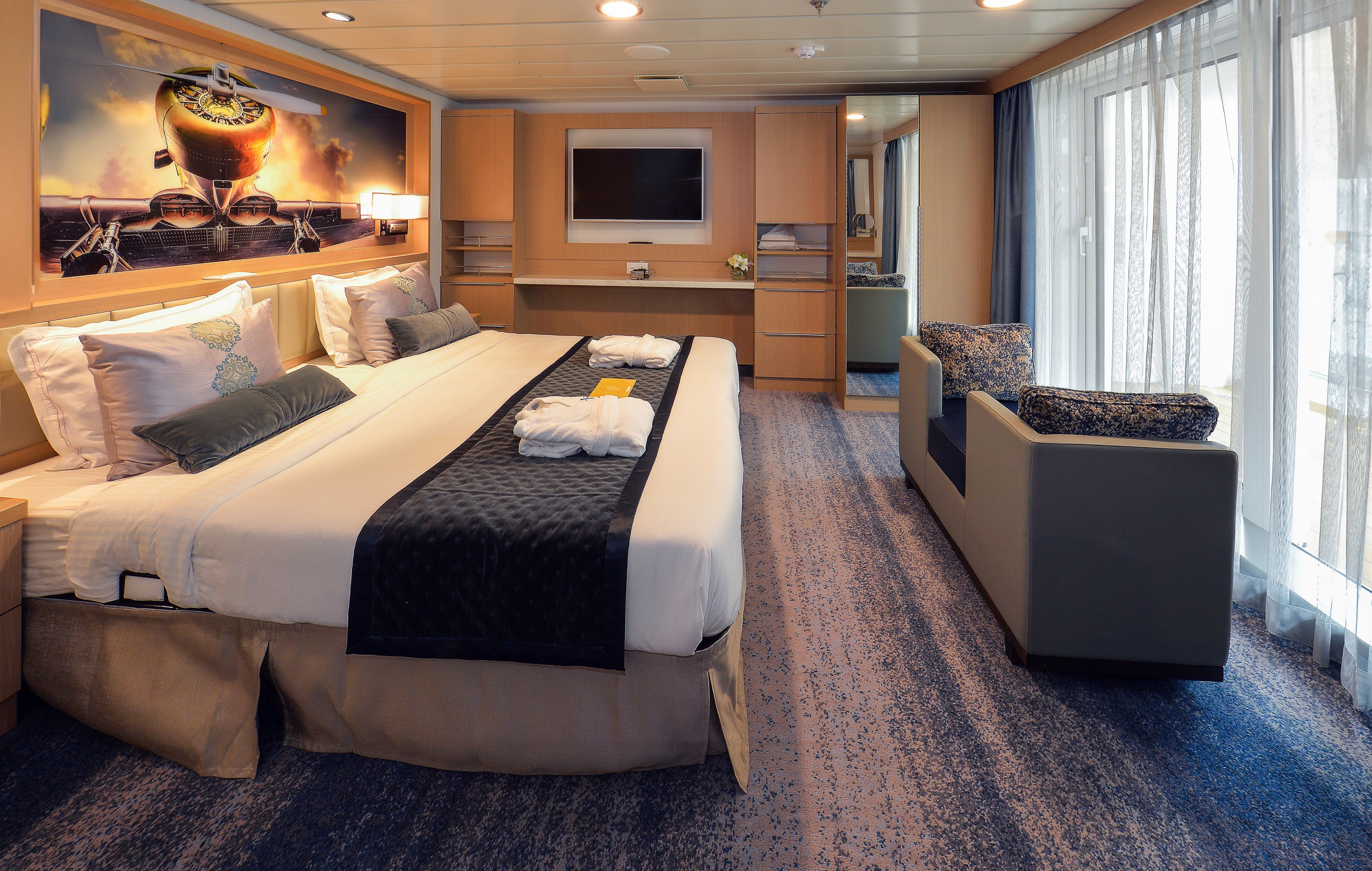
This palatial, airy apartment offers stunning views from its large private veranda on the highest cabin level. The luxurious suite features a large master bedroom, living room and dining area and two large master bathrooms, among other amenities.
Bed Config.
Two rooms. One double bed made up of two twin berths fold out sofa bed
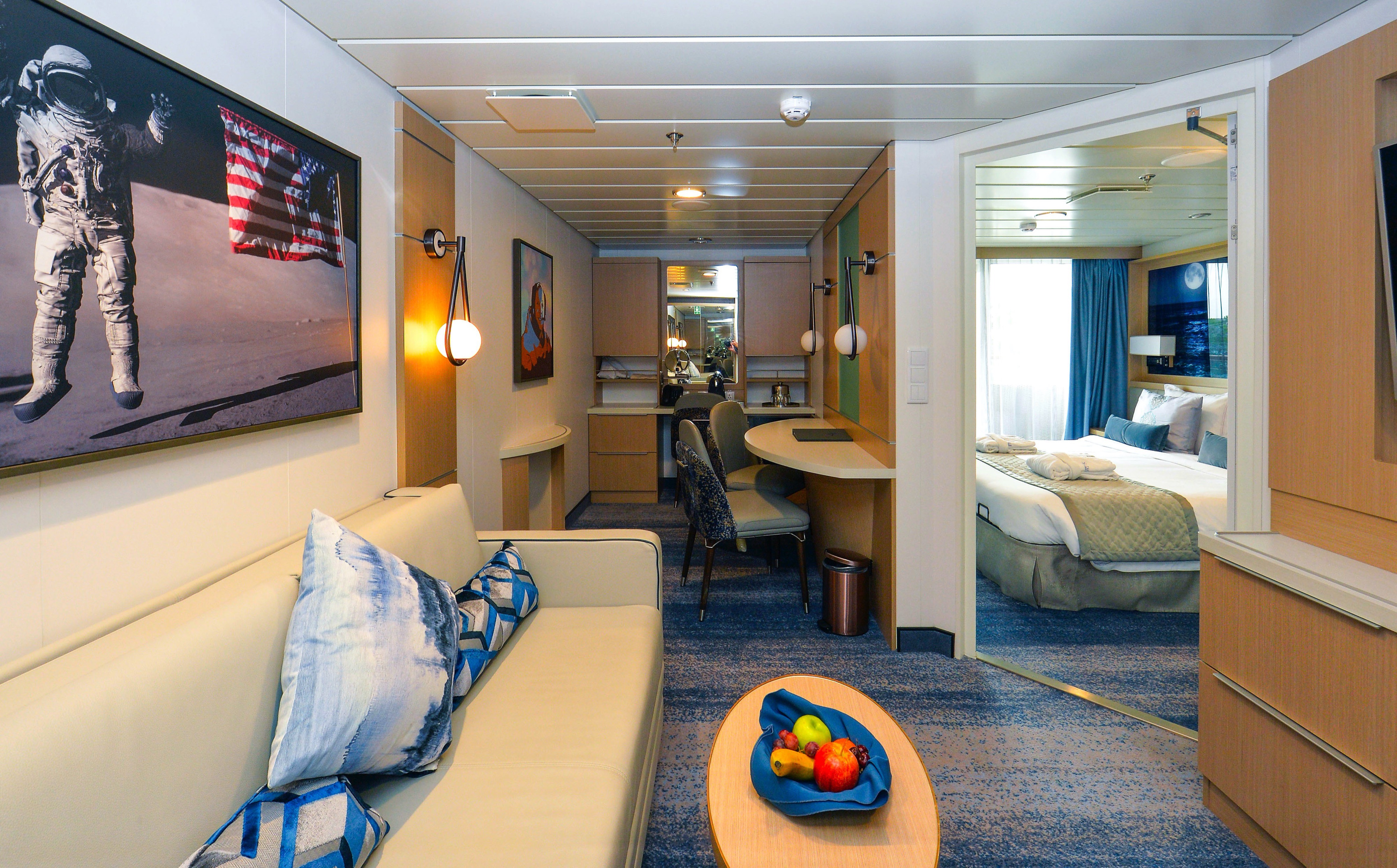
Located on Deck 6 and approximately 298 sq. f. (27.7 sq. m,) in size. These 2-room suites have one double bed that can be configured into two singles in the inner bedroom and an outer sitting room furnished with a sofa-bed, and activity table for two. From the bedroom there a floor to ceiling glass view that opens to a double sized walkout balcony. There are also 2 TV’s, state of the art ‘infotainment’ system and private bathroom with bathtub, vanity and heated floor.
Bed Config.
Two rooms. One double bed made up of two twin berths fold out sofa bed
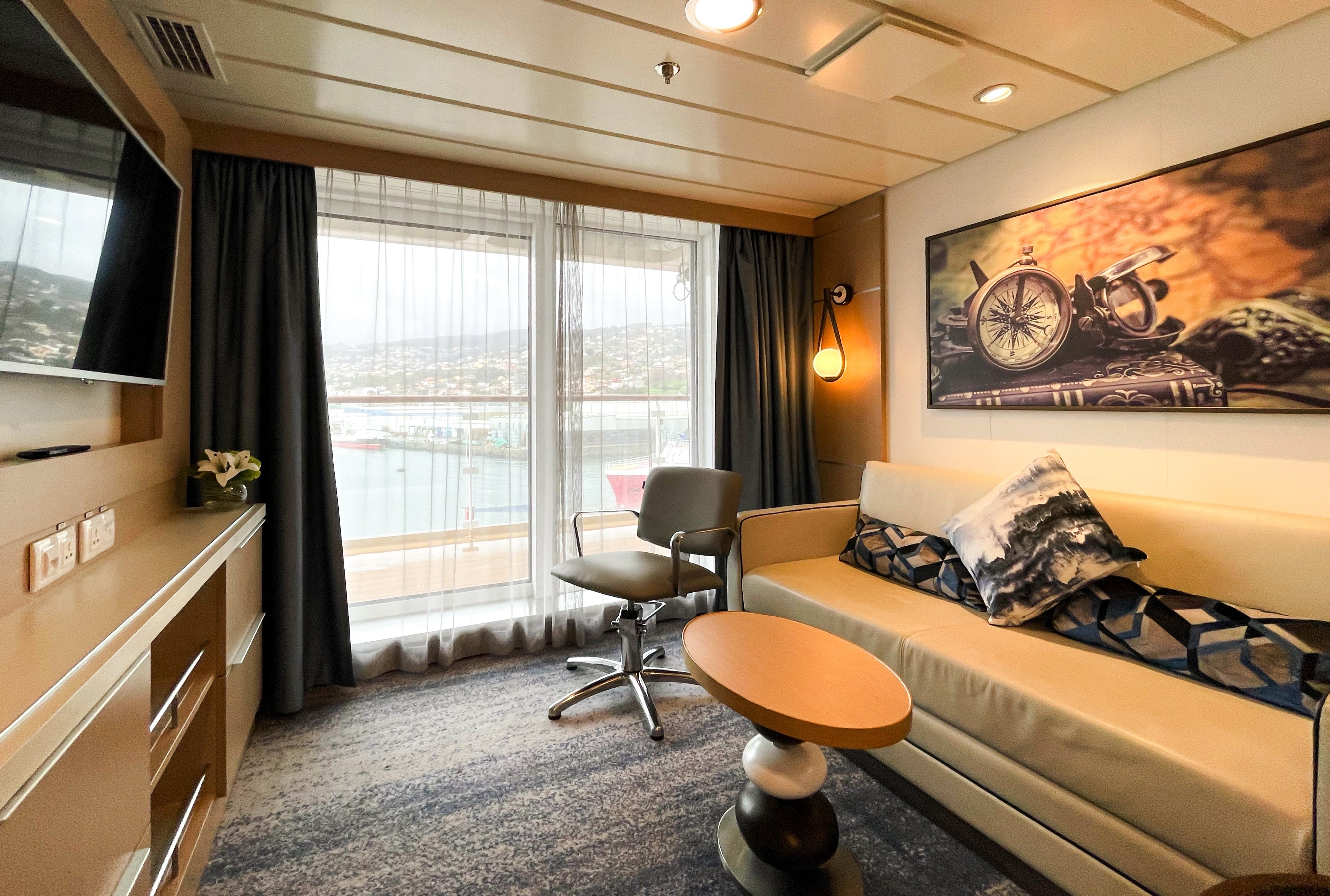
This unique 2-room suite is located on Deck 7 and is approximately 269 sq. f (25.0 sq. m.) in size. It has one double bed that can be configured into two singles in the inner bedroom and the outer sitting area is furnished with a sofa-bed. Walk-out from either room to a double sized balcony. There are also 2 TV’s, state of the art ‘infotainment’ system and private bathroom with shower, vanity and heated floor. And an additional powder room in the outside sitting area.
Bed Config.
Two rooms. One double bed made up of two twin berths fold out sofa bed
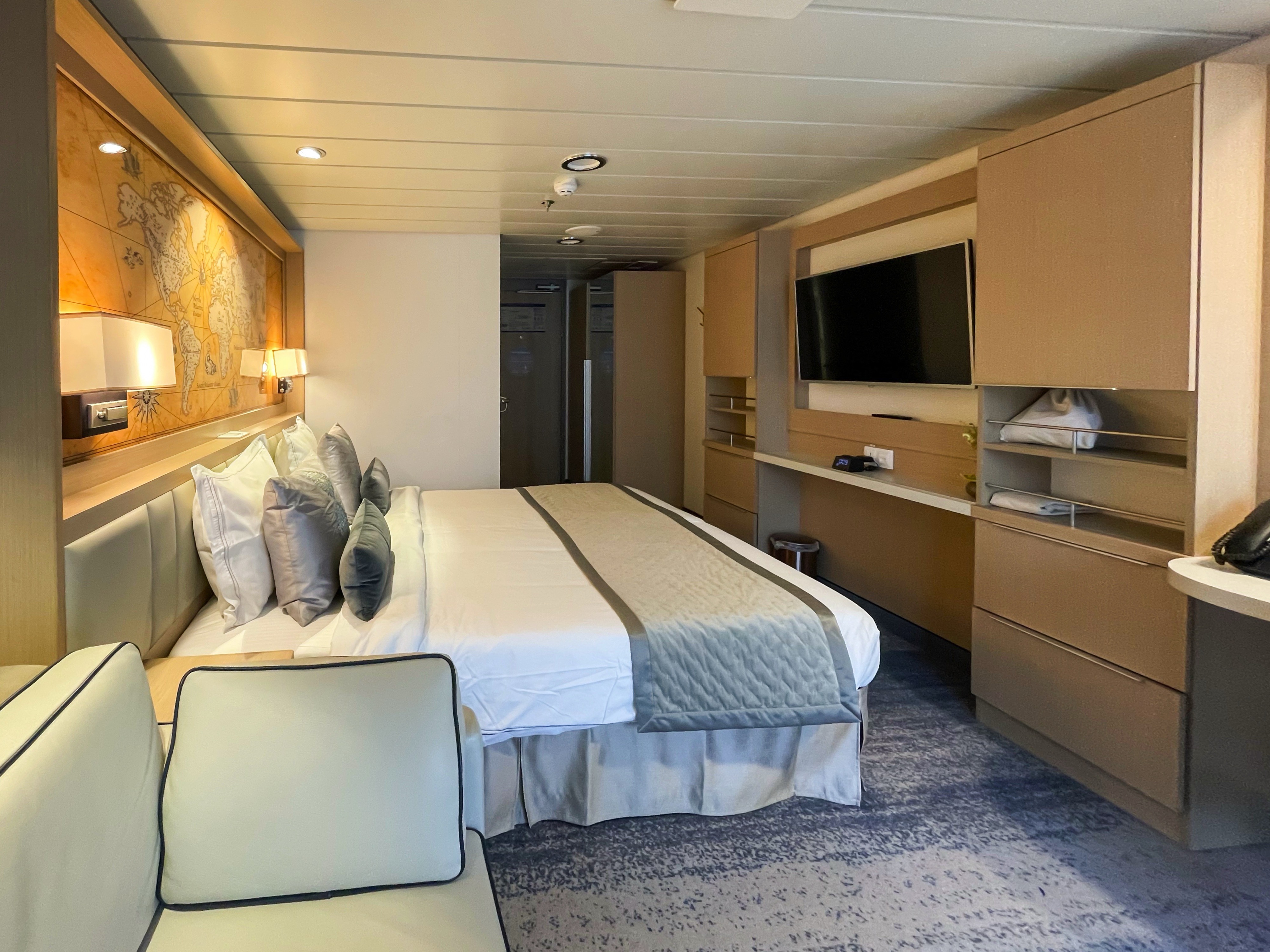
Located throughout the ship and approximately 205 sq. ft. (19.2 sq. m,) in size, these cabins have one double bed that can be configured into two singles, and separate sitting area furnished with a sofa-bed. There is a floor to ceiling glass view that opens to a walkout balcony. There is also a desk and chair, TV, state of the art ‘infotainment’ system and private bathroom with shower, vanity and heated floor.
Bed Config.
One double bed made up of two twin berths and fold out sofa bed
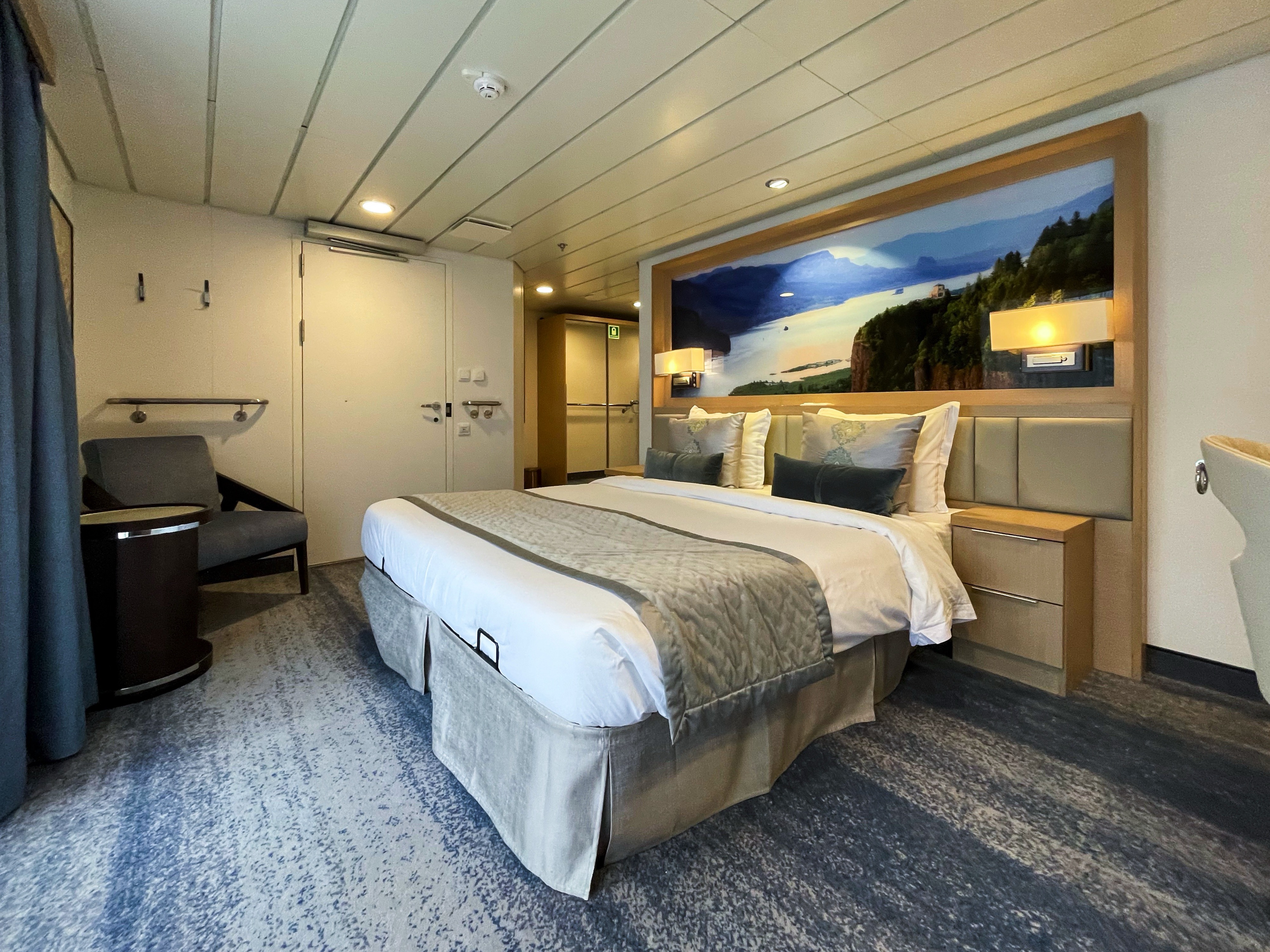
Located throughout the ship and approximately 208 sq. f. (19.3 sq. m,) in size, these cabins have one double bed that can be configured into two singles, and seperate sitting area furnished with two club chairs and a reading table. There is a floor to ceiling glass view that opens to a walkout balcony. There is also a desk and chair, TV, state of the art ‘infotainment’ system and private bathroom with shower, vanity and heated floor. Note: 611 and 612 do not have the club chairs and a reading table.
Bed Config.
One double bed made up of two twin berths plus fold out sofa bed
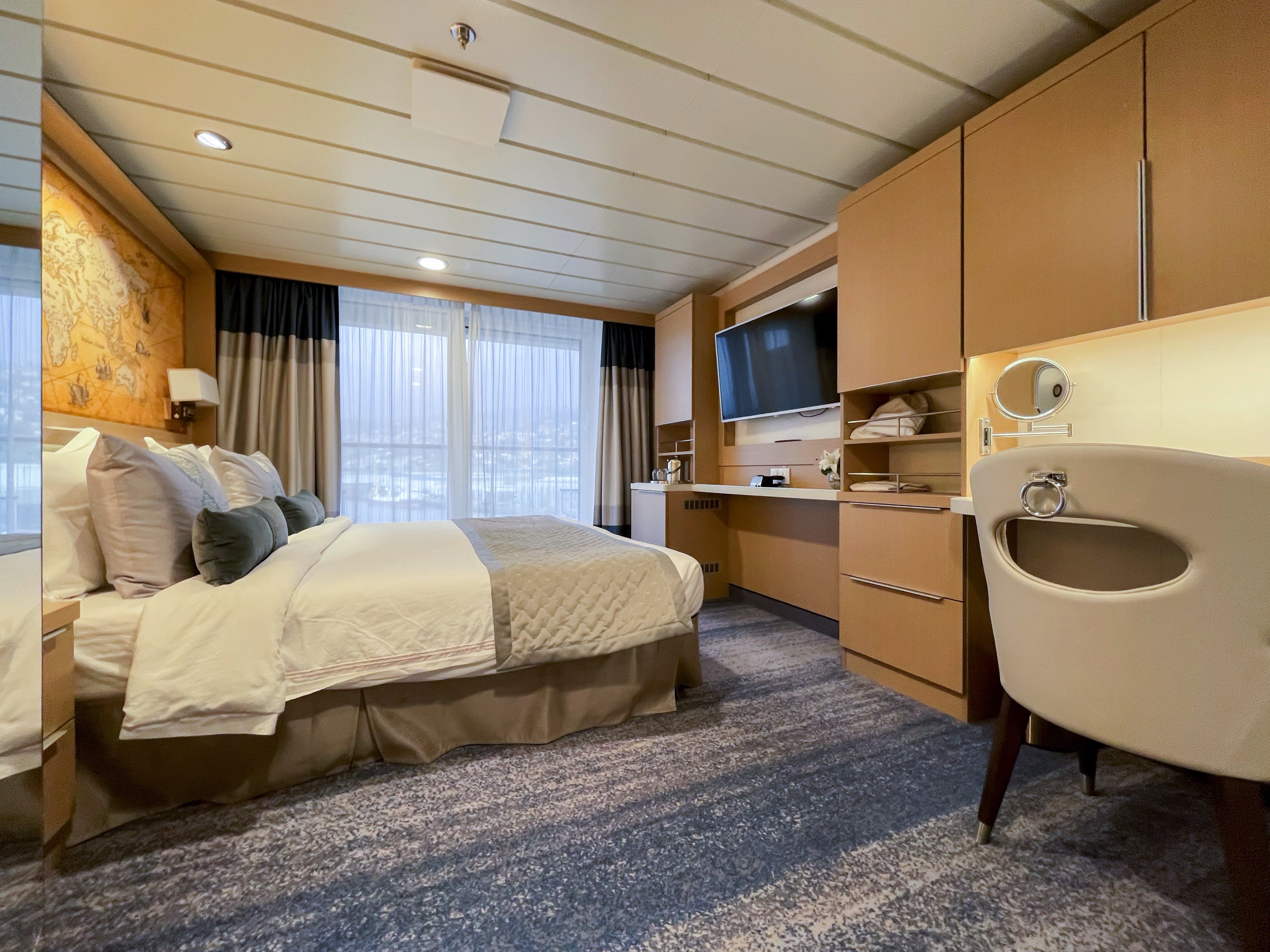
Located on Deck 4 and approximately 182 sq. f. (16.9 sq. m,) in size, these cabins have one double bed that can be configured into two singles. There is a floor to ceiling glass view that opens to a walkout balcony. There is also a desk and chair, TV, state of the art ‘infotainment’ system and private bathroom with shower, vanity and heated floor.
Bed Config.
One double bed made up of two twin berths
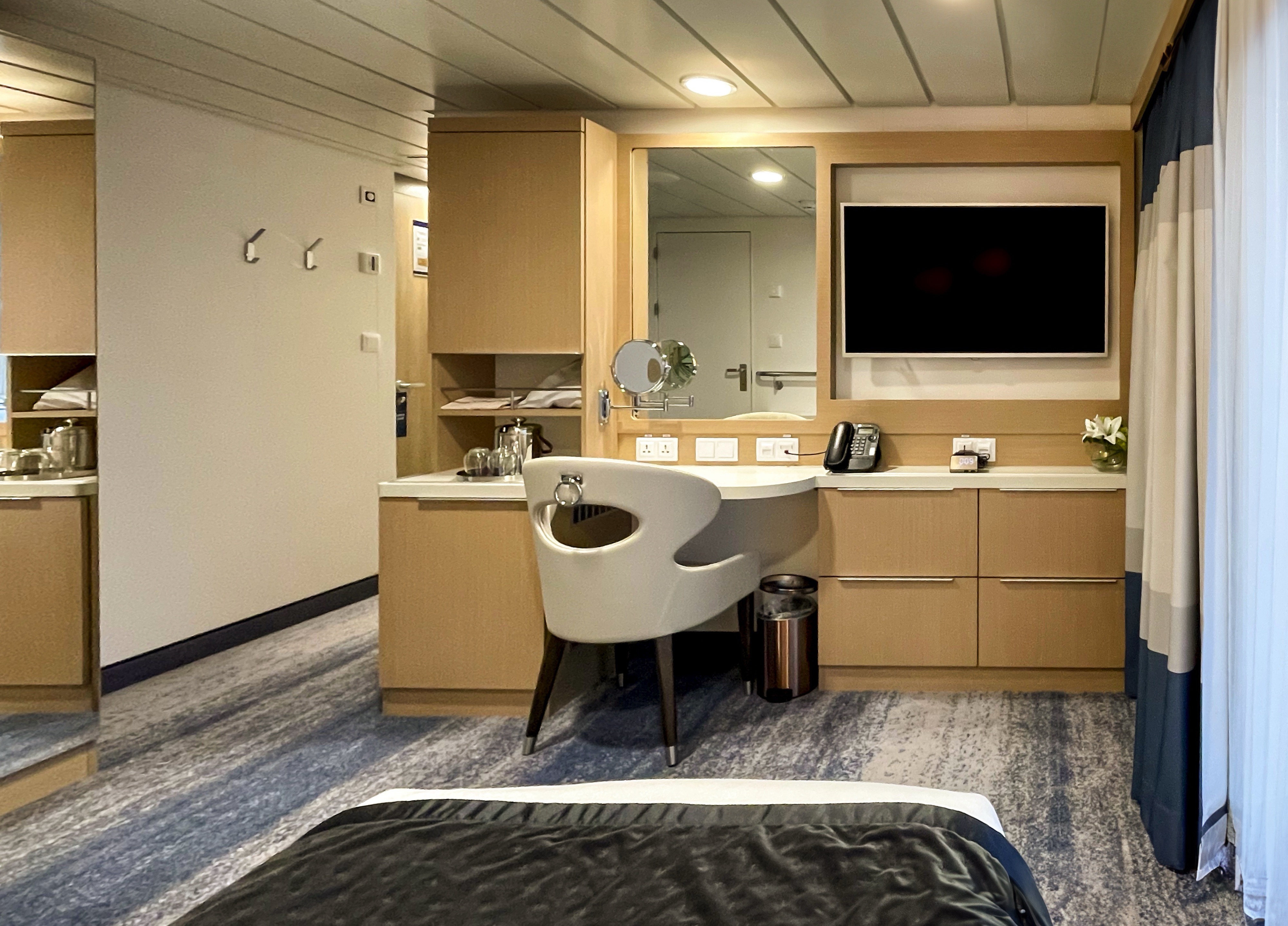
Located on Deck 6 and approximately 173 sq. f. (16.1 sq. m,) in size, these cabins have one double bed that can be configured into two singles.
There is a floor to ceiling glass view that opens to a walkout balcony. There is also a desk and chair, TV, state of the art ‘infotainment’ system and private bathroom with shower, vanity and heated floor.
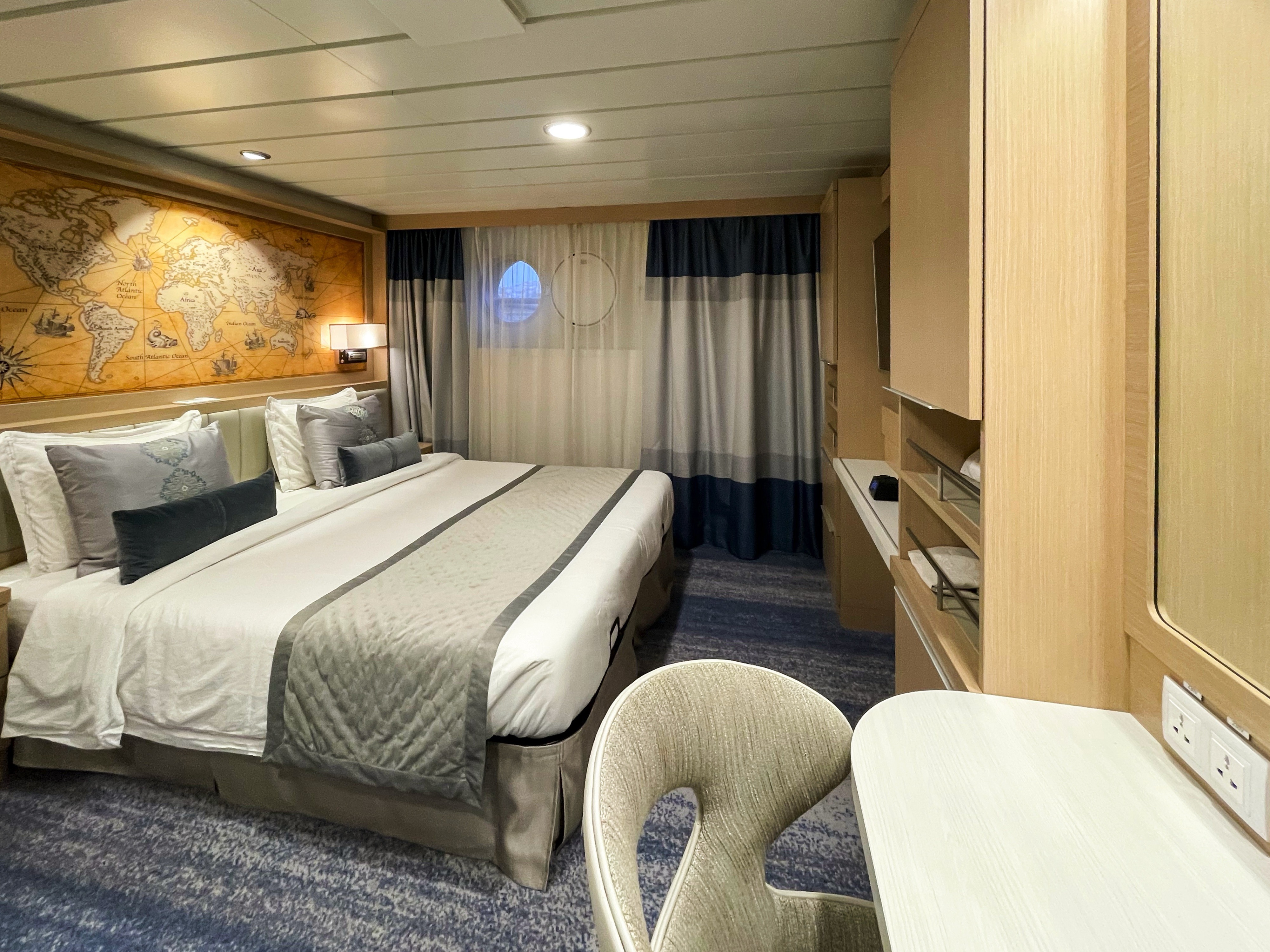
Designed for one. These cabins are located on Deck 3 and approximately 166 sq. ft. (15,4 sq. m,) in size, with one double bed and a porthole view. There is also a desk and chair, TV, state of the art ‘infotainment’ system and private bathroom with shower, vanity and heated floor.
Bed Config.
One double bed made up of two twin berths
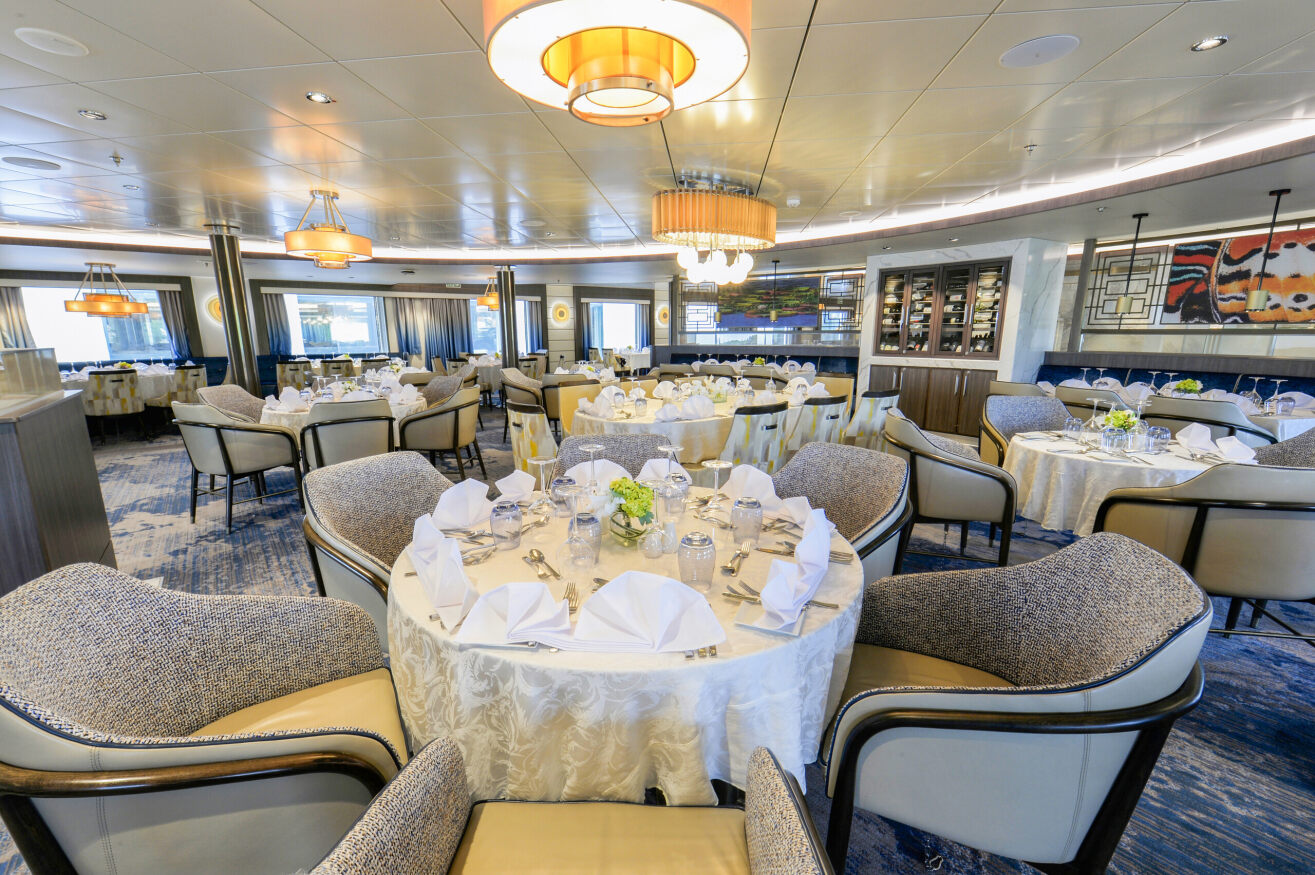
Contemporary meets cozy in this modern dining room with its stylish lighting and contemporary art. Located on Deck 5, the Main Dining Room seats 144 guests, and features expansive floor-to-ceiling windows that open onto the spectacular polar wilderness.

Tasteful and intimate. This stylish, private dining room on deck 5 provides a relaxed dining experience—with views of the polar landscape—for up to 36 guests.

With its marine blue and off-white colors—is your go-to spot for lighter fare and graband-go snacks. This relaxed eatery seats up to 44 guests, who can take in full views of their polar surroundings and wildlife while enjoying a light bite.

With four separate sea-level embarkation points and a fleet of 15 Zodiacs, Ocean Explorer offers a comprehensive breadth of off-ship activities including Zodiac cruising and paddling, allowing you to intimately connect with the polar wilderness.

The perfect polar expedition doesn’t just happen. It takes a team of talented, knowledgeable and experienced professionals to bring it all together. Our Expedition Team is comprised of seasoned veterans with rich backgrounds in marine biology, history, glaciology, geology and more. With the highest staff-to-guest ratio in the industry, our Expedition Teams safely deliver your trip-of-a-lifetime to maximize your polar adventure every step of the way.
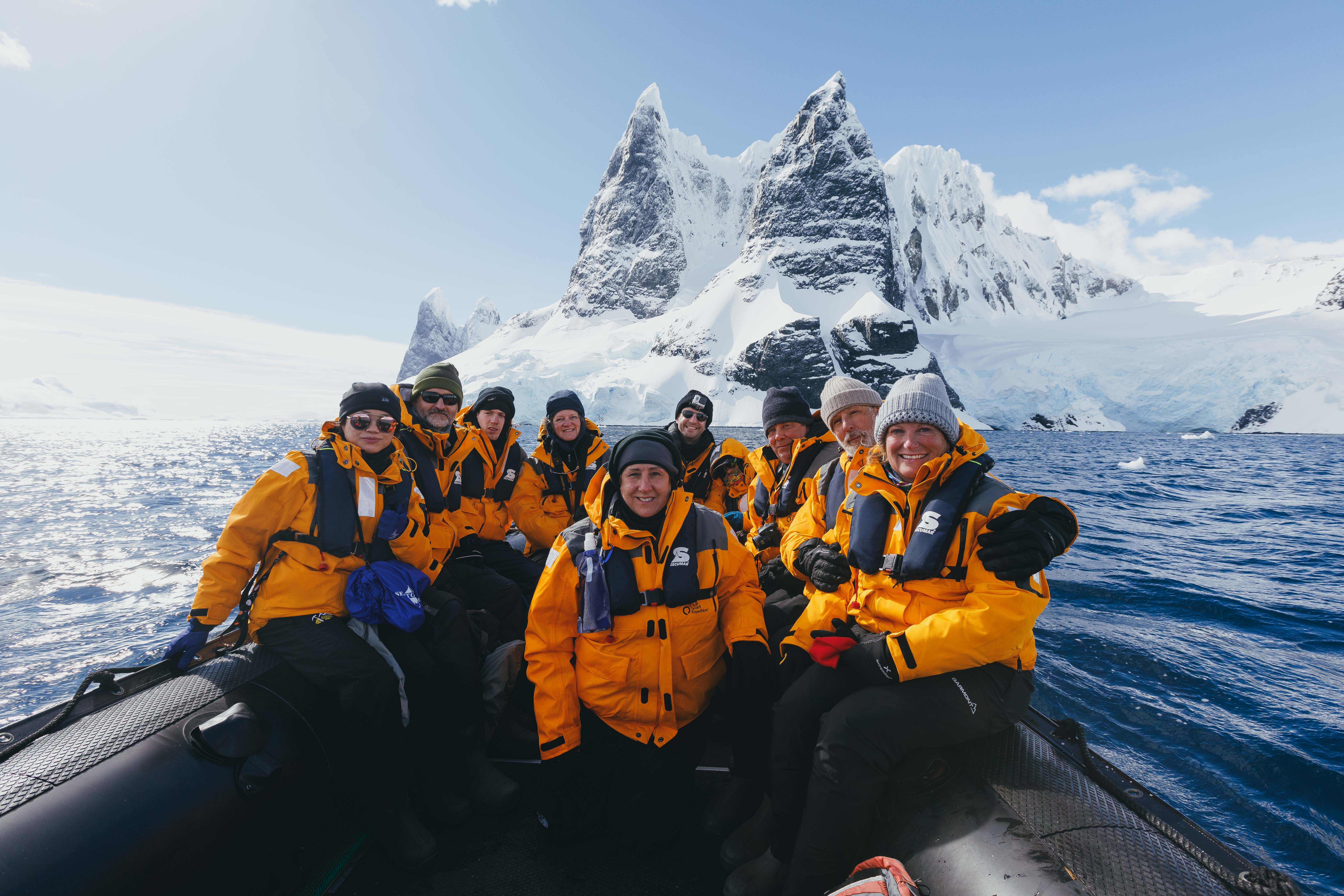
Zodiacs are used for transferring you ashore, transporting your luggage when necessary and for taking you ocean-level cruising among icebergs, whales and seabirds. During the expedition, you will visit remote and isolated sites that are accessible only by Zodiac.
These large, heavy-duty inflatable vessels are extremely safe and were specially designed for expedition work. Zodiacs are the workhorses of Polar expeditions. Separate air compartments retain a large reserve of buoyancy even if these sturdy boats are damaged. Their flat bottom design permits the craft to land directly onto the cobble and ice-strewn beaches that you will encounter on your Polar expedition.

Sea kayaking is offered on all of our departures and you require no previous experience to enjoy this activity. Our sea kayaks are the ideal means by which to get some good exercise and explore the cliffs and shores of the various visitor sites around the archipelago. A typical cruise week offers great opportunities to go kayaking around secluded coves, shores, mangrove estuaries and beautiful beaches. Galapagos penguins, flightless cormorants, sea lions and many other animals can be seen up close on a kayak and even as they swim.

Stand-up Paddleboarding, popularly known as SUPing, originated in Hawaii. Quark Expeditions is the first company to bring this watersport all the way to Antarctica.
SUPing combines the immersive experience of kayaking but in a standing position. Participants, if they prefer, can kneel, sit or even lie down and stare up at the azure Antarctic sky. Because of their wide base and tail fins, SUP boards are quite stable, enabling participants – after a bit of practice – to stop staring at their feet and admire the surrounding scenery. Imagine seeing Gentoo penguins gliding below you, or making eye contact with a Weddell seal lying on a piece of ice as you paddle by.
Guests receive on-ship and on-water instruction from a qualified SUP guide. In addition, a safety driver (in a Zodiac) stays within range to offer assistance.
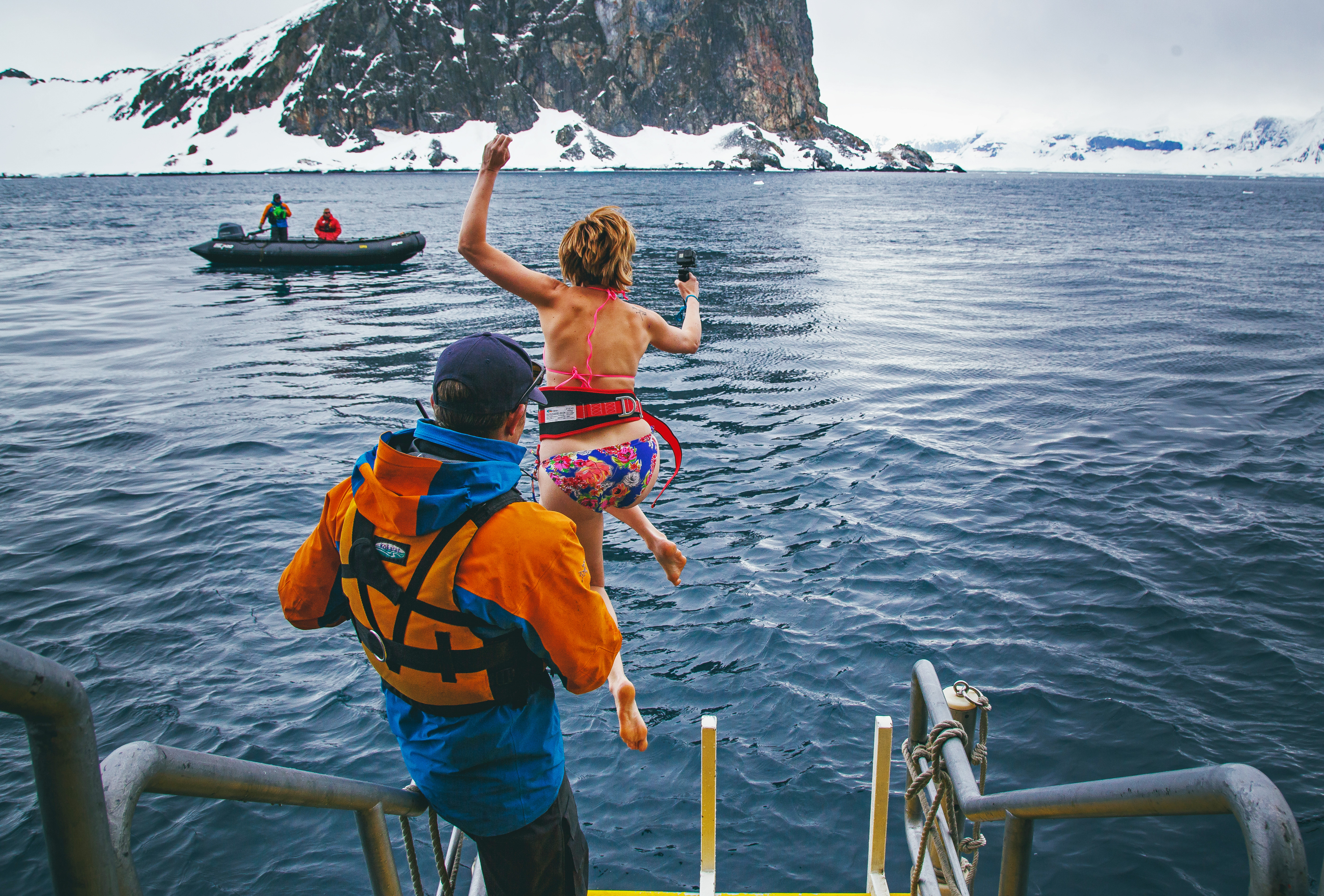
The Polar Plunge is scheduled once during each voyage. Throughout the journey, the Expedition Leader and Captain constantly monitor conditions in order to choose the optimal time and location. The Polar Plunge sometimes takes place onshore or, in many cases, from the gangway or Zodiac. All participants wear a tethered harness and plunge into the polar waters from the side of Zodiac or safety of the gangplank cheered on, of course, by fellow passengers and Expedition Team.
Safety is paramount—the onboard physician always attends the Polar Plunge. Guides in survival gear circle the area in Zodiacs as guests take their turn jumping or cannon-balling into the polar waters.
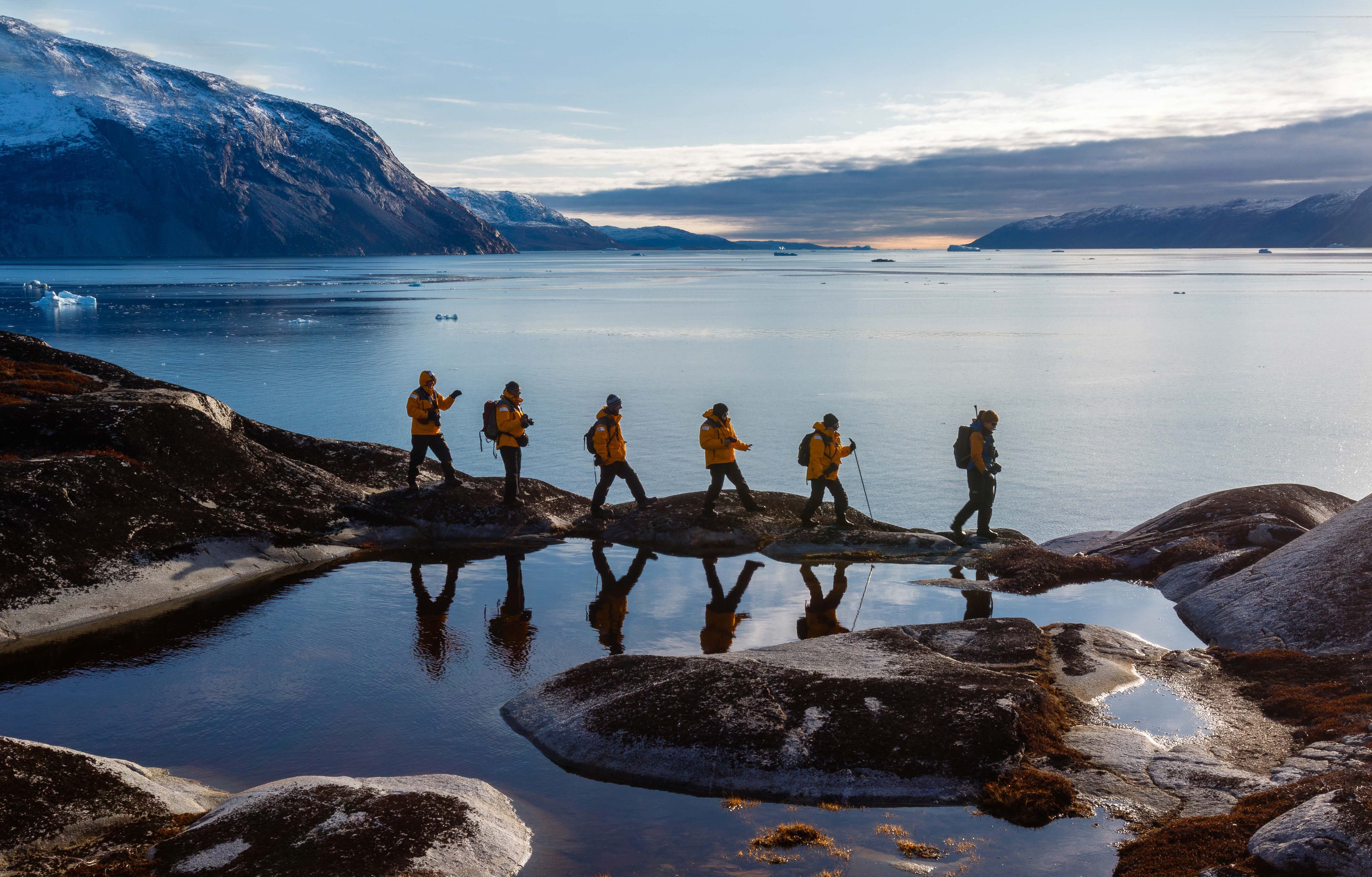
Hiking in the polar regions differs from your typical trail experience. Here, in a tree-less terrain, you are the tallest figure on the landscape as you walk over spongy tundra, crusty snow or sandy beaches in remotes parts of the Arctic and Antarctica. Stepping ashore anywhere in the polar regions means you’re not a distant observer.
Our organized hikes range from short jaunts to the top of lookouts or visits to see wildlife or longer walks of several kilometers over ice and rock and snow. Hiking excursions may last from two to three hours with plenty of time for photographs of wildlife, learning moments from your experienced guides, or just time to stand back and admire the incredible polar surroundings.
No experience is necessary but participants should be able to get in and out of a Zodiac and walk on uneven terrain. Hiking options are tailored to all interests and abilities, from those who want to contemplate the landscape in silence to photographers who want that perfect image to energetic travelers who want to summit a peak in the hopes of seeing wildlife in their natural habitat.

Explore the ocean from a more intimate vantage point on a sit-on-top kayak. No experience is required to manoeuvre these very stable kayaks, allowing you to enjoy an unforgettable experience on the water, taking in breathtaking landscapes and wildlife. Whether it’s your first time in a kayak or you want greater flexibility to try other Adventure options, this shorter excursion is for you.
Paddling in the Polar Regions is highly weather-dependent and a one-time experience. Your kayak guides will attempt to take you out on the water for 1-1.5 hours of paddling. Offered on most voyages, spaces are limited. All equipment, guides and instructions are provided by Quark.
Pricing subject to change based on season. Please proceed to checkout or contact a Polar Travel Adviser for more details.

Imagine for a moment, staring at the stars in the indigo glow of an Antarctic night as you bed down for the night outside in the elements. The buzz of your daily life becomes a distant memory as you listen to the bray of penguin, the ethereal calls of the Weddell sea – even the exhalation of a humpback whale. And then you fall asleep.
Antarctic Camping with Quark Expeditions is an unforgettable experience. After dinner onboard, you’ll be escorted ashore by Zodiac to camp out on the snow for the night in your ready-to-roll bivy sack (tents can be used upon request). Once you decide on your spot, you set up camp and enjoy the peace as the Antarctic night unfolds.
Camping in Antarctica is limited to 50 participants, all of whom will be briefed beforehand on the principals of basic camping. Prior to you settling down for the night, Quark Expeditions staff will prepare the site, including setting up a perimeter in safe, flat to gently-sloping and beautiful site. You’re free to choose where (within the perimeters) you want to settle down for the night.
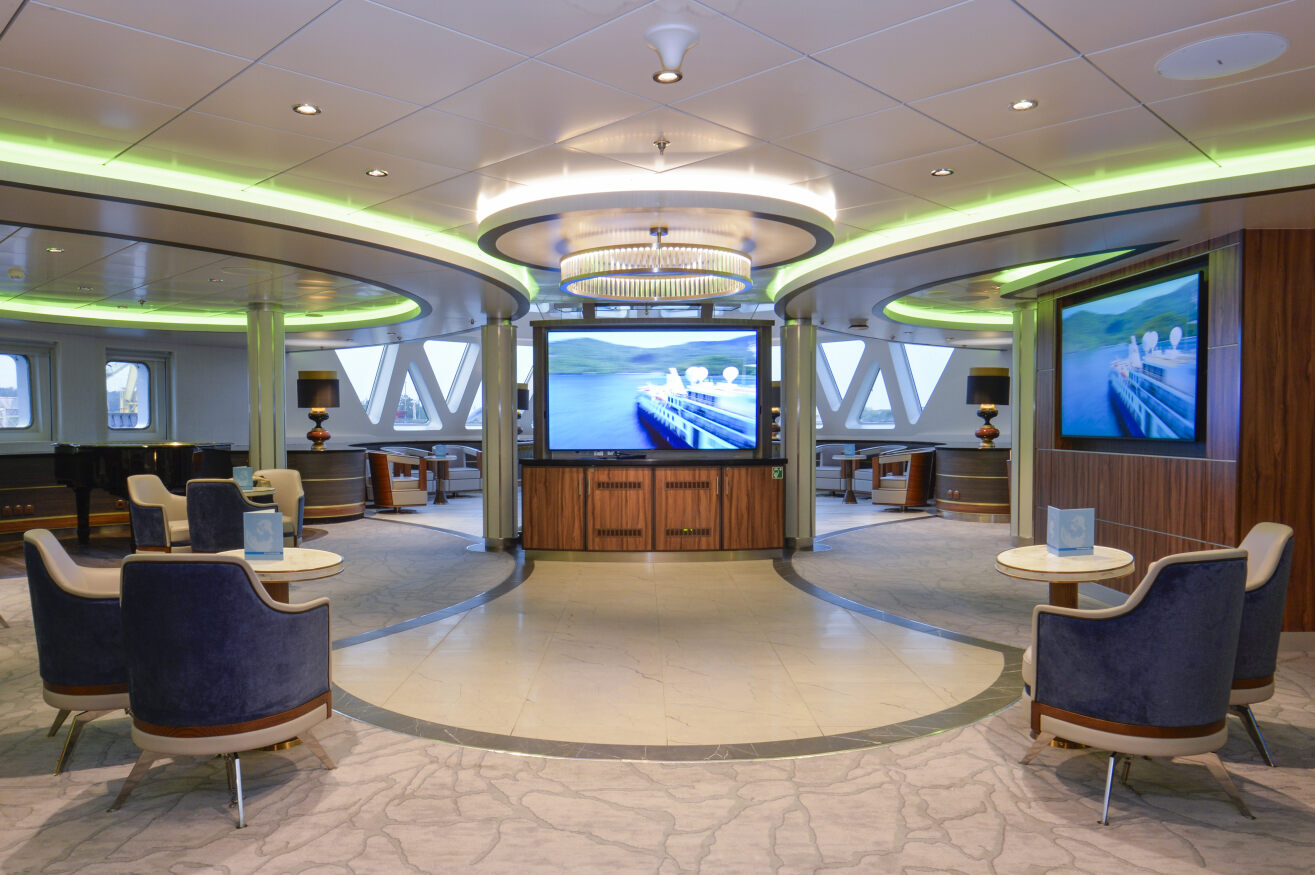
Enjoy daily chats with and presentations by our world-class onboard polar experts—expedition guides, specialists, photography guides and other special guests who will introduce you to the fascinating history, biology, ornithology, glaciology and geology of the region, and much, much more.
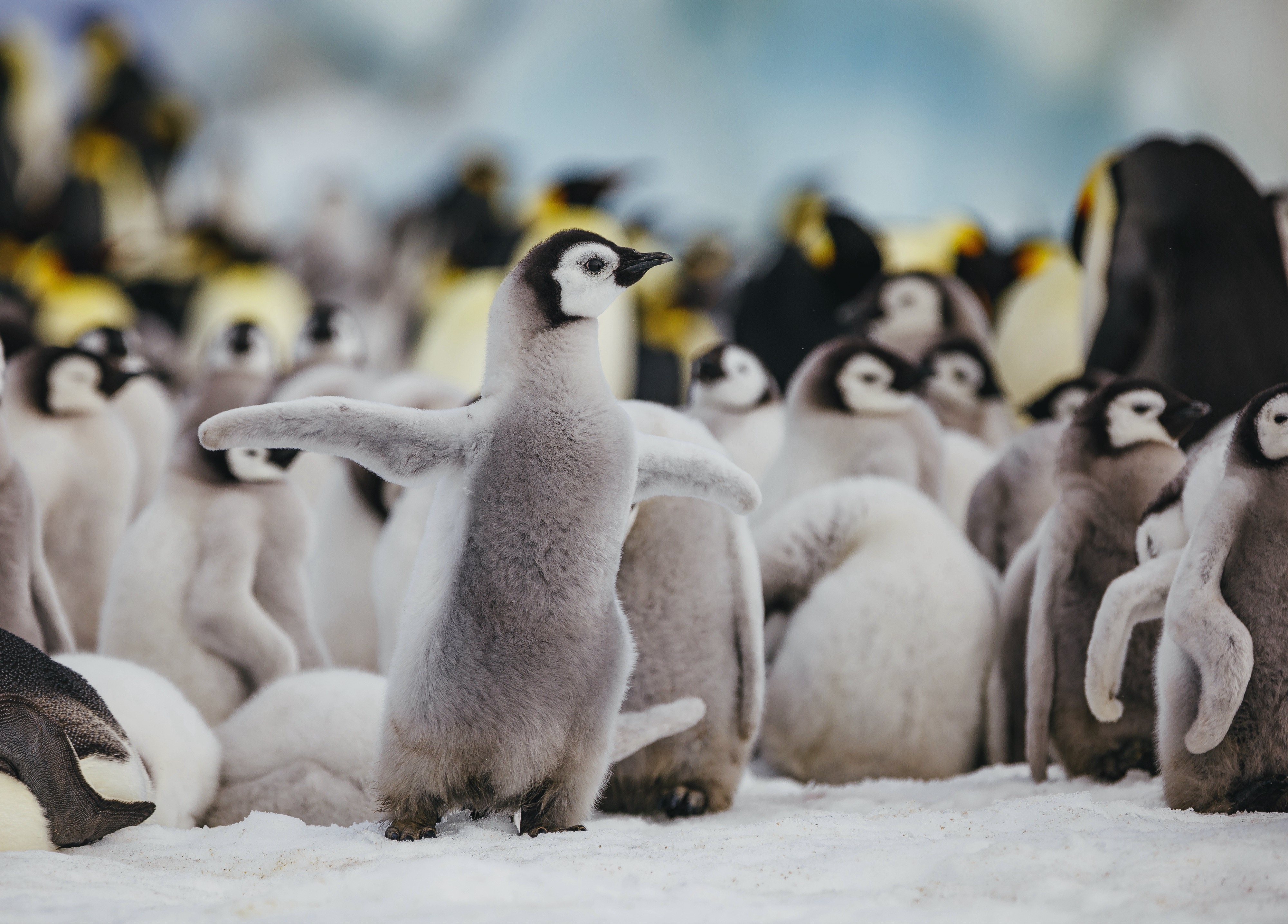
Documenting your voyage so you can take the memories home is a rewarding experience. Our photography guides will help you hone your skills to capture the beauty of the polar regions.
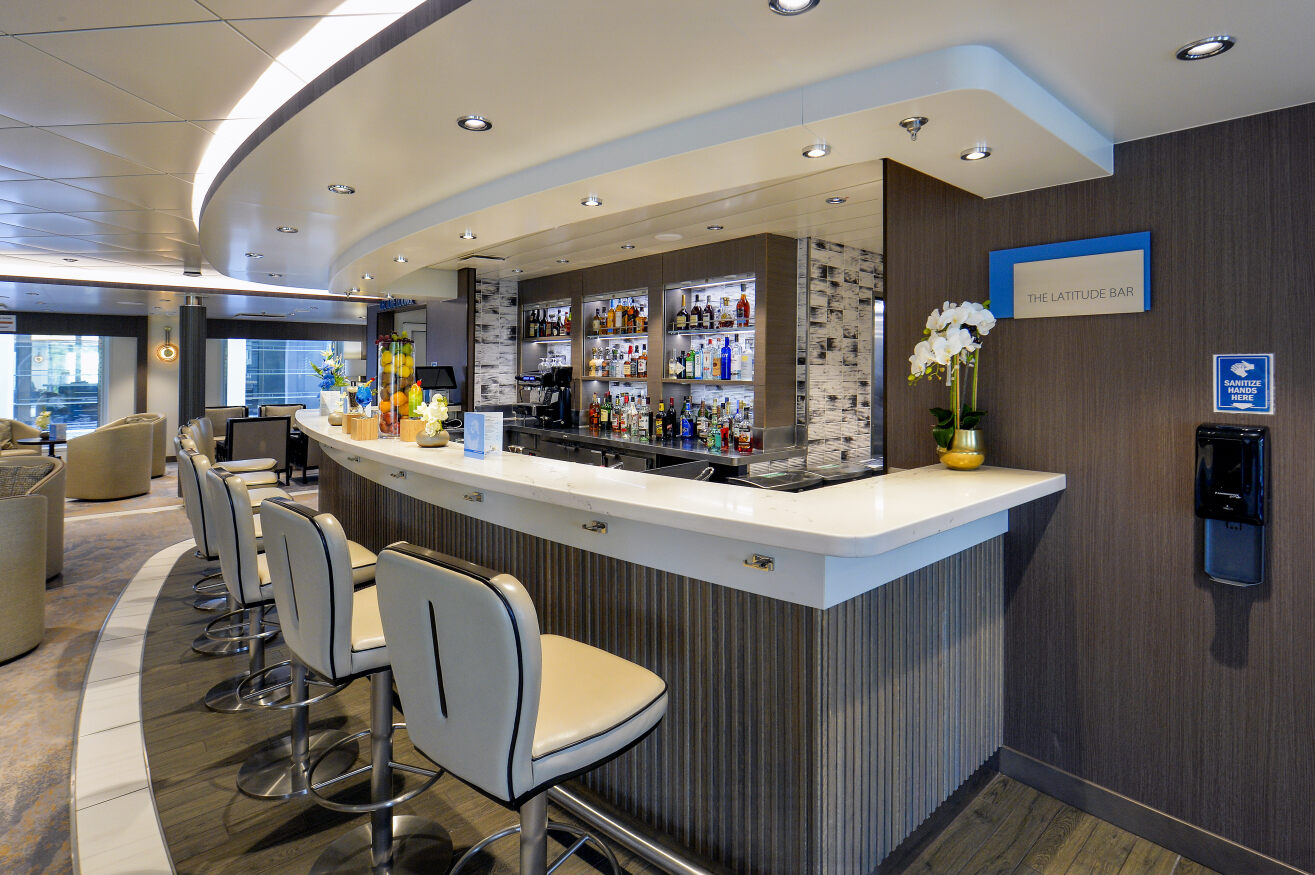
A popular social hub on Deck 5, the beautifully-lit Latitude Bar—with its lush sofas and faux marble-topped end tables—is large enough to seat 46 and is ideal for enjoying a quiet drink on your own or hanging out with friends.

This stylish lounge at the top of the ship guarantees incredible views. Guests also frequent this spacious lookout on Deck 8 to enjoy cocktails and conversation with fellow travelers. Seats 63.
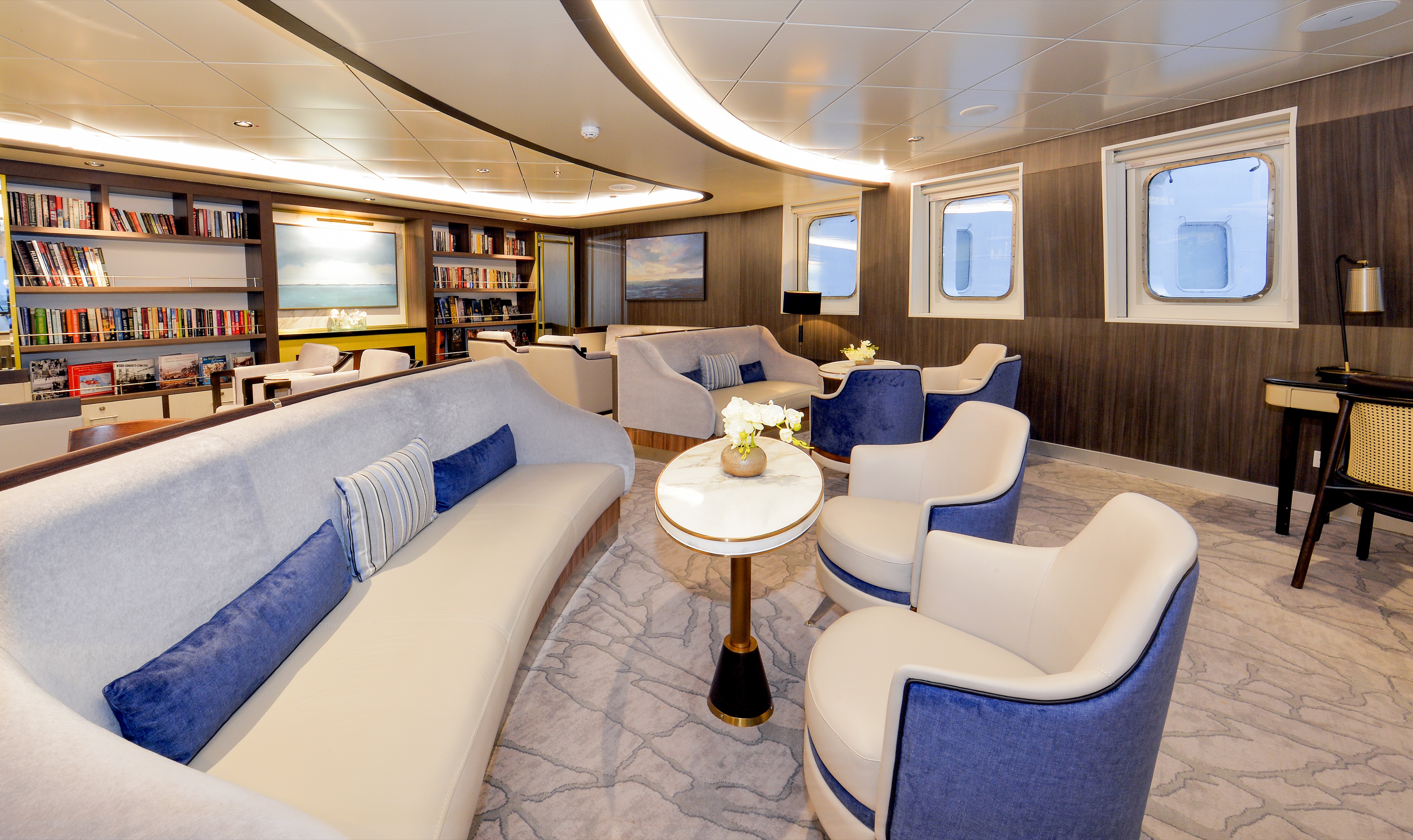
Located on Deck 6 at the top of the gorgeous atrium staircase, this beautiful Library with floor-to-ceiling glass, accommodates up to 47 people.
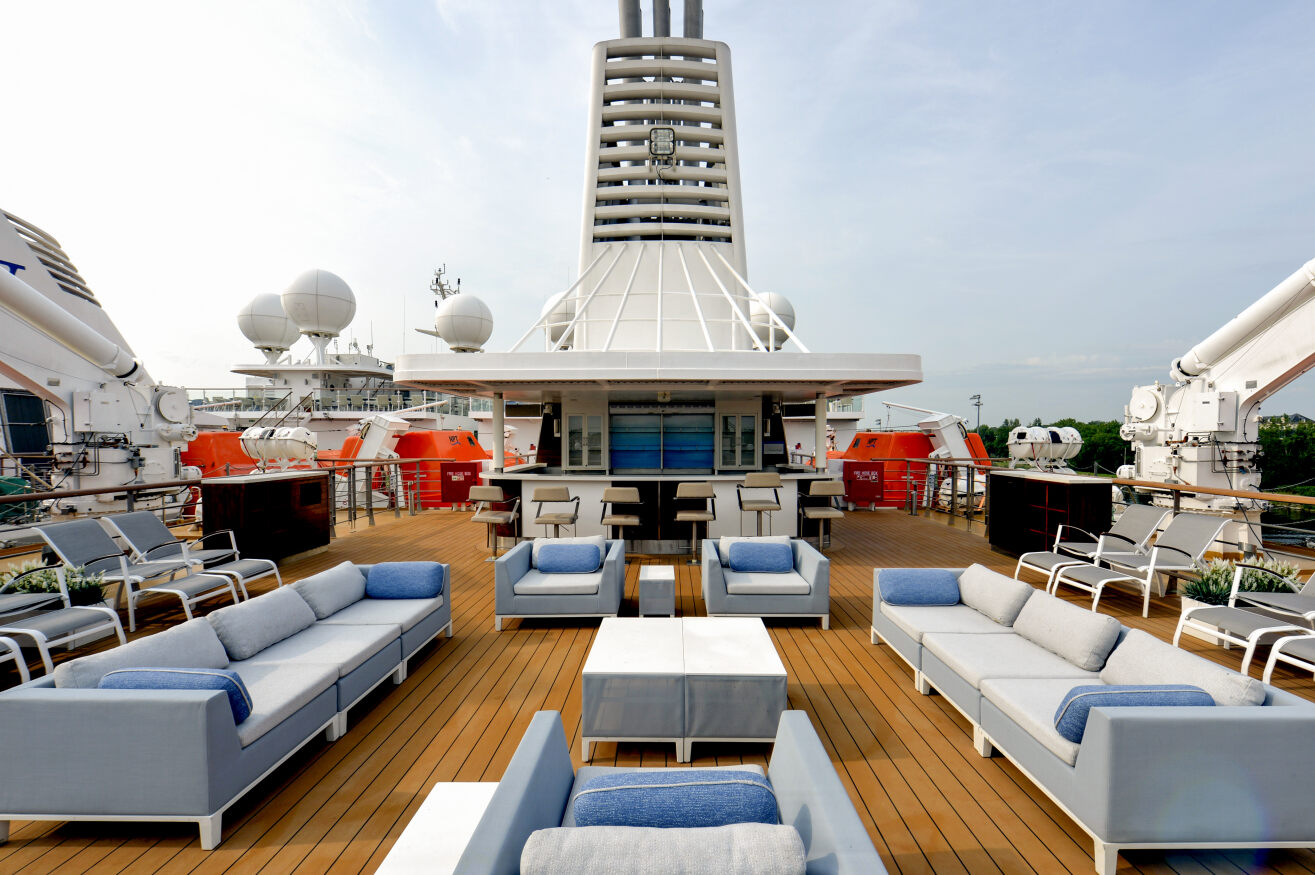
More information coming soon.
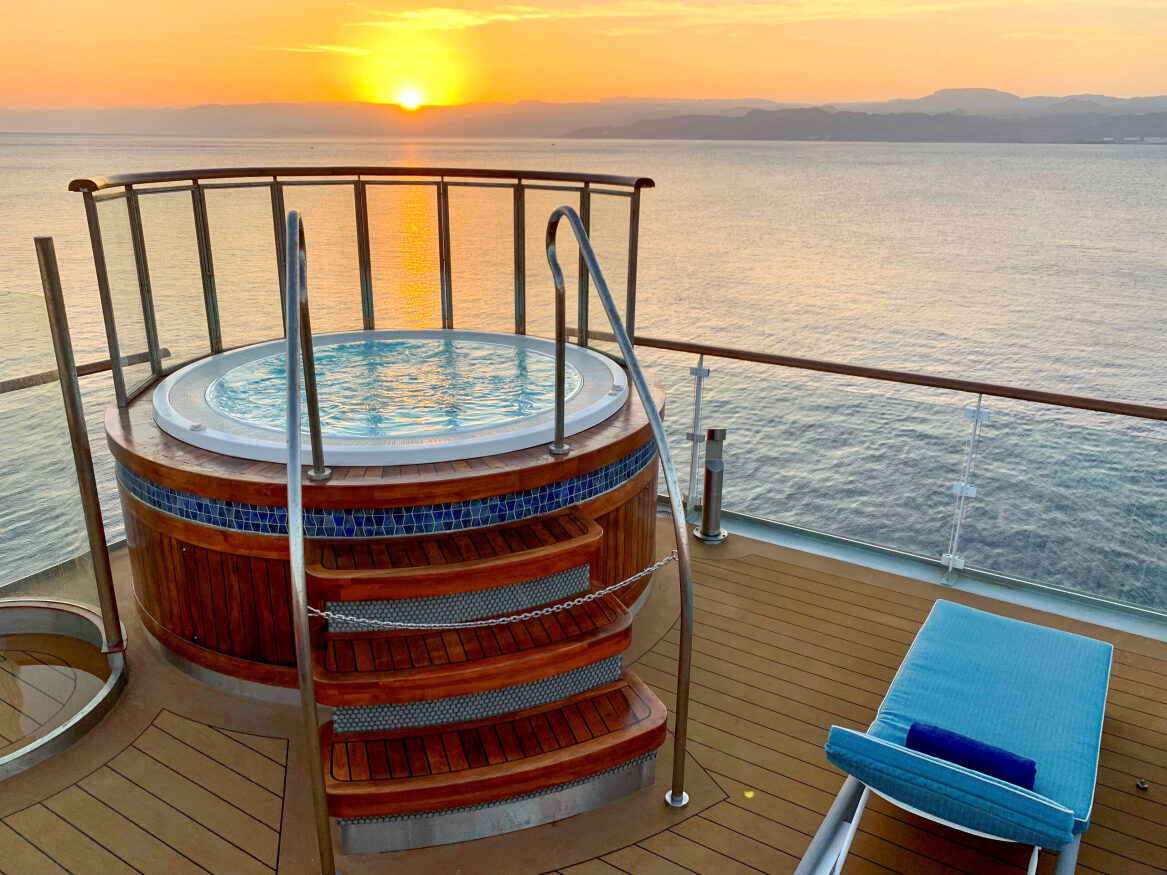
Two outdoor Jacuzzis on deck 7, at the ship’s stern, mean you can relax alfresco while soaking up the breath-taking polar views.
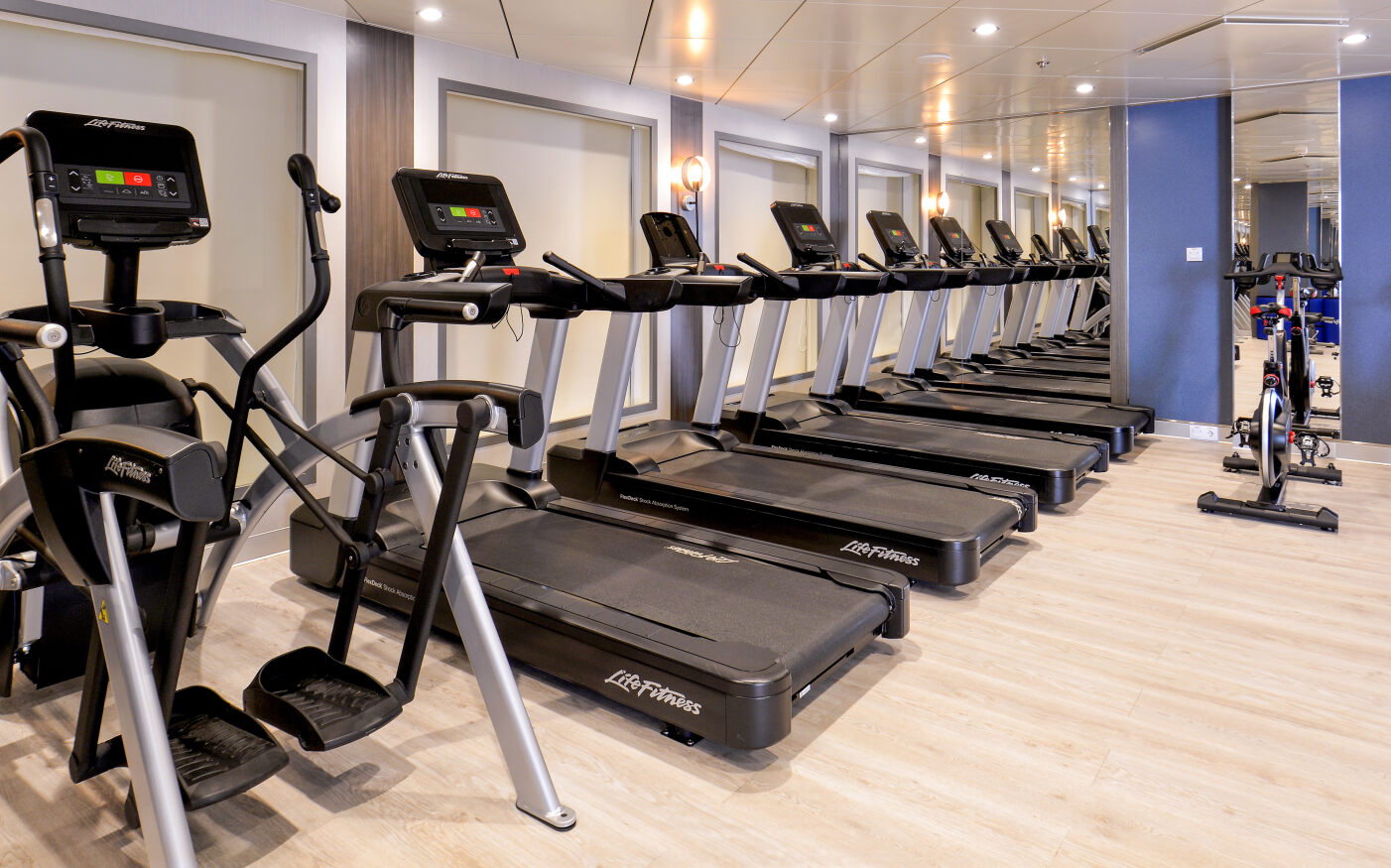
Stay fit with the latest work-out equipment in the Fitness Center on Deck 7.
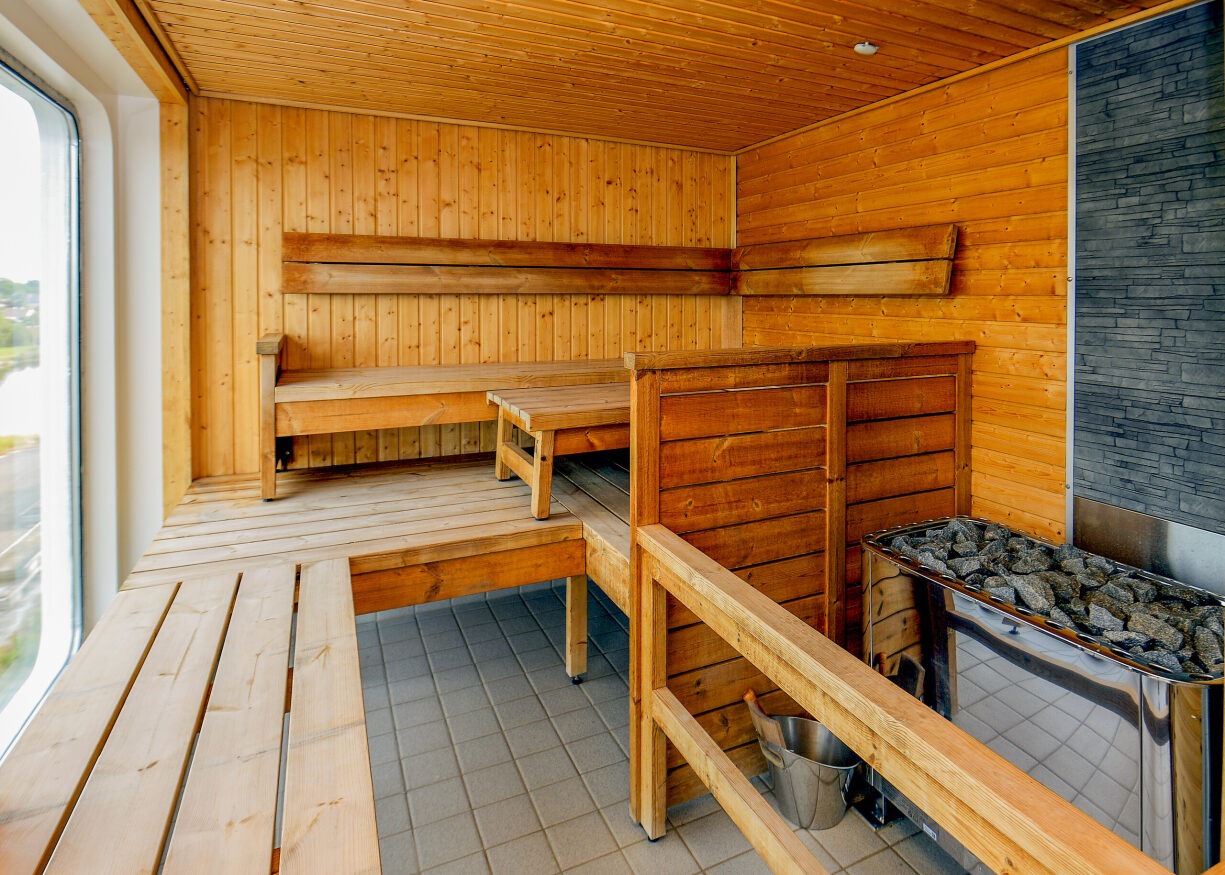
After a day of exciting off-ship adventure, guests can relax on the sauna’s traditional wood benches while gazing at the polar wilderness just outside the large sauna windows. Accommodates 15 people on Deck 7.
With the latest sustainability technology in polar expedition, the ship features fuel-efficient Rolls-Royce engines and the ground-breaking MAGS gasification system that converts waste into energy, eliminating the environmental impact of waste transportation.
Quark Expeditions provides an English-speaking doctor on board who manages a medical clinic stocked with a supply of common prescription medicines and basic first aid equipment.
If you are under regular treatment for any ailment, you must bring a sufficient supply of medicine. We recommend that you pack an extra two weeks’ supply of medication in case of emergency. We cannot accept responsibility for not having a specific brand or type of drug on board. Should you fall ill, the doctor will refer to the medical forms that you completed and returned to us; therefore it is vital that the information you provide is complete and accurate
The dress code on the ship is casual, though some may choose to dress up a little for the Captain’s Welcome Reception.
To protect the health and safety of its guests, Quark Expeditions® maintains a no smoking policy in the interior of the ship including cabins, near Zodiacs and on landings. Smoking on the ship is permitted in the designated smoking area only, which your Expedition∘ Team members will be happy to point out for you. Always make sure to extinguish cigarettes properly and dispose of them in the proper receptacle. Please, never throw cigarettes overboard.
All guests—including vegetarians, meat-eaters, as well as those who follow a gluten-free diet—will be equally impressed with the dining options on our ships. Quark Expeditions® is able to cater to most special dietary requests, as long as you clearly indicate your needs on the required expedition forms when you book your voyage. Menus will be clearly labeled for vegetarian and gluten free options, but please do notify your server of the dietary restrictions you indicated on your form. We regret that kosher food cannot be prepared.
A complete list of laundry fees will be provided on board. Laundry is collected each morning; please allow 48 hours for your laundry to be returned. Ironing services are also available at a minimal charge. We encourage you to take advantage of the laundry services, as it will mean you can pack fewer articles of clothing. If you prefer to hand wash small items in your cabin, please remember to bring environmentally friendly detergent.
When you are not busy exploring the natural beauty of the Polar Regions, you may wish to connect with family and friends back home to share some of your voyage highlights. Guests on Quark Expeditions can now enjoy free Wi-Fi as part of our “Raise a Glass and Stay Connected Free” program. This complementary Wi-Fi service permits basic Internet browsing and voice applications.
Please note that we travel to some of the most remote parts of the world. As we utilize satellite equipment for our connection, Wi-Fi signal may be intermittent.
To access email or internet on your personal computer, tablet or smart phone, connect to the network on your device, where you can access our complimentary plan, or purchase Priority Wi-Fi.
Complimentary Wi-Fi
- Lower speeds
- Suitable for basic internet browsing, texting and voice calling using text and voice apps
- Some site filtering
- No charge
- One device logged in at a time
Priority Wi-Fi
- Higher speeds
- Suitable for larger data volume apps, video calling, video streaming (in lower resolutions) etc.
- See rates by logging in
- One device logged in at a time

- Top Deck

- Observation Deck
- Observation Bistro
- Observation Lounge
- Elevator

- Penthouse Suite
- Owners Suite
- Veranda Stateroom
- Dry Sauna
- Fitness Center
- Jacuzzis
- Bridge
- Observation Deck
- Sun Deck and Bar
- Elevator

- The Discovery Library
- Junior Suite
- Veranda Suite
- Veranda Stateroom
- Elevator

- Main Dining Room
- Private Dining Room
- Reception
- Polar Boutique
- Explorer Lecture Lounge
- Elevator

- Deluxe Veranda Forward
- Veranda Suite
- Veranda Stateroom
- Expedition Desk
- Elevator

- Ready Room
- Medical Facilities
- Zodiac Embarkation Points
- Studio Single
- Elevator

